Federica Pich: I’d like to start our conversation with a quote from Michael Baxandall’s Patterns of Intention (1985: 4): «Past tense and cerebration: what a description will tend to represent best is thought after seeing a picture». I suspect a literary scholar would have been unable to capture the essence of verbal description – the shift that is implied in any attempt to represent a picture into words – as poignantly as this particular art historian does here. It is a question of perspective, of positive displacement – of being able to see more when we step outside the realm of our own discipline. My experience here at the Courtauld has been quite unique in this respect. Besides rekindling my interest in intermediality, conversations with students and colleagues have changed the way I look at pictures and, perhaps more surprisingly, the way I read texts.
It was that same search for new perspectives – facilitated by the chance to spend more time in London’s libraries over the last few months – that first led me to your work, Michael. When I read your article on the epigrams on Myron’s cow (Squire 2010a), for example, and your chapter on ekphrasis for the Oxford Handbooks Online in Classical Studies (Squire 2015b), they both stood out to me as much more intellectually refreshing and helpful than many theoretical contributions I had come across during my own research on ekphrastic poetry in the Italian Renaissance. I felt that your view of the subject could speak effectively to someone with a different expertise – precisely because your thoughts were moving from specific objects and texts, which you analyzed in great depth, while never losing sight of wider issues. This made me wonder how you first got interested in themes of image and text. Was it your interest in individual authors or texts that led you to themes such as ekphrasis and visual poetry, or was it rather the interest in these themes that guided your selection of texts? For that matter, what took you to classical materials in the first place?
Michael Squire: That’s quite a compliment – thank you, Federica! The discipline of classics can sometimes feel rather claustrophobic. Of course, our field is a wonderfully interdisciplinary one, since we have to work with all manner of different media and methods. But, as an academic subject, classics is defined around a set of chronological and historicist parameters. By contrast, the very topic of visual-verbal relations requires us to think in broader, theoretical terms. Classical materials prove particularly rich here because they of course provide the basis for all subsequent thinking about visual-verbal relations (not least, as you have shown, in the Renaissance). At the same time, to think about the theme of ekphrasis across the longue durée of western cultural history helps to bring into focus both similarities and differences in perspective.
I have to admit that I never set out to focus on issues of word and image. From quite early on, I knew that I wanted to study the ancient world – I was always fascinated by those issues of similarity and difference. What appealed to me about classics was the chance to study a culture through so many different lenses: literature, history, philosophy, visual culture, archaeology (as well as, of course, issues of reception). Although my undergraduate training was philological – centred around Greek and Latin – I got more and more interested in ancient art; I also began to recognize a widening gulf between scholars specializing in literary topics and those working with visual materials. I guess I decided to pursue a doctorate in ‘visual and verbal interactions in Graeco-Roman antiquity’ because I wanted a topic that allowed me to work between the fields of art history and literature.
In terms of whether it was themes or else authors that have directed the things I’ve worked on, it was definitely the themes! But one of the things I enjoy most in my research is the way in which those themes take me to objects, authors and texts that have been so forgotten, dismissed or underplayed by classical scholars. The 36 Greek poems on Myron’s cow preserved in the Palatine Anthology are just one example (AP 9.713–42, 793–98): Goethe famously condemned the epigrams as «monotonous and dull [eintönig]…, neither descriptive nor informative» (trans. Goethe 1986: 23–24); in the twentieth century, influential scholars like A. S. F. Gow and Denys Page characterized the same poems as «commonplace and foolish» – «a somewhat tedious competition in thinking of a new way to say that it was a very lifelike representation of a cow» (Gow and Page 1965: 2.64, on AP 9.720 (Antipater of Sidon 36)). For me, what was so interesting about these poems is the trope of replication that they play out: a trope, of course, that you have also traced in your own work on Renaissance materials…
F.P.: Yes, as someone trained in Renaissance Studies, I’ve looked at a similar cultural interest in replication, albeit ‘played out’ in different ways – not only when it comes to Petrarchism as a poetic system, but also with regard to ekphrastic poetry specifically. As you know, in my book (Pich 2010) I traced the development of a tradition of vernacular and Neo-Latin poems about portraits, a work that implied in the first place the mapping of a well-established repertoire of patterns, motifs and conventions employed in writings about art and largely inherited from antiquity. At various times, I found myself dealing simultaneously with synchronic and diachronic sorts of repetition.
This leads me to a related question, concerning the attitude that for a long time has guided art historians when confronting poems on works of art. Generally, they have looked for documentary evidence or straightforward ‘description’, a task which understandably has often proven disappointing if not misleading. By contrast, another distinctive feature of your approach is the fact that your awareness of what we cannot expect to find in epigrams on works on art – extensive description of visual detail – does not prevent you from acknowledging the critical potential of what we can actually find in them. In other words, the pars construens of your arguments is no less crucial to your work than your part destruens, which is not very often the case in visual studies. How can non-descriptive texts provide a powerful contribution to ancient visual discourse?
M.S.: Well, I think we have to begin here with that term ‘visual discourse’ itself: one of the things visual cultural studies have taught us is the complexity of ‘visual discourse’ – extending into all manner of cultural arenas. At the same time, ‘description of visual detail’ is itself culturally loaded – description is never neutral or objective.
In terms of ancient epigrams specifically, everything depends here on the expectations we bring with us. If we turn to Greek and Latin epigrams on artworks hoping that they’ll provide museum-like ‘captions’ we’re going to be disappointed: they weren’t written in order for scholars some two millennia later to reconstruct lost artworks! The point is exactly analogous to what you have demonstrated regarding Renaissance materials: in the field of classics, there has likewise been a whole industry of using epigrams to reconstruct lost artworks (e.g. Benndorf 1862). Yet if we try to understand the epigrams on their own terms – which means in part contextualizing single examples against others, and in part situating them within their cultural contexts (about vision, imagination, modes of critical responses, literary display, etc.) – they can speak volumes. And they can have a key and undervalued role to play in making sense of the visual and literary cultures to which they belong.
This is why I’ve taken issue with debates about the term ‘ekphrastic epigram’ in the ancient world – debates that have surged in particular since the publication, in 2001, of a new corpus of epigrams attributed to Posidippus. In a series of important and stimulating articles, Graham Zanker has led the bid to abandon the term, at least in association with pre-Byzantine epigram: «like the current use of the word ‘ekphrasis’ itself, the name of the category is a modern invention», he has argued; «these poems were very rarely intended to give a vivid description… They were poems about statues, paintings and gems» (Zanker 2003: 61, 62, recapitulated in 2004: 184–185, n.26). To my mind, the debate here has been framed in the wrong terms: there remains a problem with assumptions that, in order to qualify as an ‘ekphrasis’ (whatever we mean by that term!), a text had to evoke the formal and physical traits of the object described. Zanker argues that «given epigram’s naturally small format, it must limit explicit, detailed description»; «they were very rarely intended to give a visual description of the appearance of the works of art they celebrate» (Zanker 2003: 61, 62). But epigrams toy with their promise and failure to visualize their subjects in much more sophisticated ways: they play with the topos that, no matter how ‘descriptive’ their evocations, they offered readers a different sort of visualization from images; or to reverse the point, they interrogate what it means to view, and what it means to represent viewing through words (as I argued in e.g. Squire 2010b). As such, epigrams on artworks fit into a longer tradition of Greek thinking about words that speak for pictures – and about pictures that visualize words: a tradition that stems all the way back to Homer, I’d suggest, and which was epitomized in the famous dictum of Simonides that ‘a picture is a silent poem and a poem is a speaking picture’.
F.P.: I have a feeling that Simonidean adage is going to come up again in our conversation! At the same time, though, the tradition also of course extends all the way forward to the Renaissance (as so nicely demonstrated in recent years by Barkan 2013). But before coming back to that, can I return to that issue of ‘description’. As you know, there’s been much talk about the concept of «notional» as opposed to «actual» ekphrasis – a distinction that was proposed by John Hollander (1995), differentiating between texts inspired by actual works of art and imaginary ones. In your 2010 article on the Myron’s cow poems and elsewhere (e.g. Squire 2009: 145–146), you argued that this category is of limited help – that it can be potentially misleading in imposing a distinction onto materials which were (and need to be) thought of as part of the same literary tradition.
The same is true for the texts with which I am more familiar, namely poems celebrating portraits in the Italian Renaissance. For instance, it is essential to acknowledge that the same topoi and motifs circulate in poems that would fall on different sides of the «actual»/«notional» distinction. In my view, the idea of «notional» ekphrasis is likely to make us overlook important visual connections or rhetorical possibilities embedded in the ekphrastic tradition, regardless of the actual existence of the works of art it engages with. What are your thoughts about this?
M.S.: Interesting! Well, I’m not against any sort of categorical or systematic distinction if it proves helpful or productive – if it can help us to make better sense of what we’re studying. And some classicists certainly have tried to make use of Hollander’s distinction – as when, for example, one scholar writes that «whereas the descriptions in epic poetry are fictive, those in elegiac poetry and also in epigram are more likely to refer to specific objects» (Leach 2004: 10).
In my own work, I’ve found the distinction just as problematic as you have done with Renaissance materials. On the one hand, as W.J.T. Mitchell has shown, every image that is ‘ekphrastically’ represented is in some sense absent, substituted by the text that evokes it (Mitchell 1994: 151–181, esp. 157–158, n. 19): by definition, ekphrasis is in some sense «notional», refracting a supposed material referent into a configuration of language.Progymnasmata – is premised on the idea of summoning up a visual impression: fundamental was the idea of enargeia (‘vividness’) – the notion that words might summon forth images in the mind’s eye of the reader. Ekphrasis, in other words, is both a verbal and a visual phenomenon, regardless of precisely how (or whether) any particular verbal evocation related to any particular visual paradigm. I think the «notional»/«actual» distinction risks flattening out that conceptual complexity. Indeed, one of the things that most interests me about ancient ekphrasis is the knowing play on such questions of ‘authenticity’ – something nowhere more spectacularly demonstrated, I think, than in the Imagines of the Elder Philostratus (cf. e.g. Squire 2013b; Squire and Elsner 2016).
Let me add one other quick footnote to that. We’ve talked of the Myron’s cow poems – that is, epigrams on a statue of a bronze heifer forged by Myron in the fifth century and displayed on the Athenian Acropolis (and later taken to Rome). But in light of Hollander’s distinction, one might well ask: are the poetic responses here responding to a ‘real’ or ‘notional’ object? Now, I don’t doubt that there was an ‘original’ statue, and one that came to be replicated (even if scholars very much debate what the statue looked like). But the material object nonetheless took on a poetic life of its own independent of the original statue. In the 70s AD, Pliny the Elder not only associates Myron with the statue, but adds that its fame is thanks to ‘famous verses’ («for many people owe their reputation not to their own talent but to someone else’s»: Natural History 34.57–58)…
F.P.: Before moving on to another topic, a last question on ‘ancient’ ekphrasis proper – returning to your mention of the Progymnasmata. Ruth Webb’s 2009 book on Ekphrasis, Imagination and Persuasion in Ancient Rhetorical Theory and Practice advocates a different and specific meaning of ancient ekphrasis, as opposed to later and modern uses of the word. In your view, what are the main arguments in favour of and against a clear-cut distinction between the two meanings?
M.S.: The essence of Ruth Webb’s argument is that the ancient term ‘ekphrasis’ (literally a ‘speaking-out’) meant something quite different from what it has come to mean in the late twentieth and early twenty-first centuries. That important 2009 book builds upon a 1999 article published in Word & Image (which again looked at the historiography of the term – and its rise to fame in the hands of Leo Spitzer in the mid-twentieth century). Where word-and-image studies have tended to stress the continuities between ancient and modern critical traditions, Webb argues, ancient thinking about ekphrasis had little to do with artistic subject matter, and everything to do with a culturally contingent «set of ideas about language and its impact on the listener» (Webb 2009: 1).
Not only is ekphrasis not conceived as a form of writing dedicated to the “art object”, but it is not even restricted to objects: it is a form of vivid evocation that may have as its subject-matter anything – an action, a person, a place, a battle, even a crocodile (Webb 1999: 13).
Webb is of course absolutely right to pinpoint the specific framework in which ekphrasis was discussed by ancient rhetoricians. And she offers a wonderful discussion of how the phenomenon was discussed in ancient handbooks of rhetoric – the Progymnasmata of Theon, Pseudo-Hermogenes, Aphthonius, Nikolaus and others. Likewise, her comments have led scholars to rethink numerous aspects of ancient rhetorical theory, and in a host of fruitful ways: the importance of Webb’s contribution here can be seen in e.g. the stimulating exchange of Muth/ Neer/ Webb 2012.
But, in my view, there has been an unfortunate side-effect. While concentrating on the supposed gap between ‘ancient’ and ‘modern’ traditions of theorizing visual and verbal representation, there remains a danger of overlooking certain proximities (and indeed continuities) between them. In particular, I would take issue with Webb’s recourse to the Progymnasmata alone to reconstruct an ‘ancient’ critical framework: ancient ekphrasis needs to be considered in much broader terms – rhetorical discussions themselves need to be set against literary and literary critical traditions (cf. Squire 2008; Squire 2013a – in the context of classical antiquity’s prototypical ekphrasis, namely the Homeric description of the shield of Achilles).
As I see it, the strange, puzzling, and contradictory claims of the rhetoricians about ekphrasis only make sense against (and as part of) broader Graeco-Roman interrogations of the nature of vision. When the Progymnasmata define ekphrasis as a «speech that brings the subject matter vividly before the eyes», they are resonating against theories about visual-verbal relations on the one hand, and about visibility and invisibility on the other. Webb is quite right to insist on the Greek term’s breadth of meaning. But as she admits, ekphrasis was always understood to interrogate the nature of sight and insight, regardless of the particular subject: «any ekphrasis rivals the visual arts in that it seeks to imitate their visual impact»; indeed «any ekphrasis is haunted by the idea of the work of art» (Webb 2009: 83-84: cf. 194). While Webb argues for a much more complex definition of rhetorical ekphrasis than the one scholars have often assumed, the reluctance to treat the phenomenon from a perspective beyond the Progymnasmata seems rather reductionist in scope. Here I would add that, for all their ‘schoolboy’-oriented discussions, the Progymnasmata are really revealing on the paradoxes of ekphrasis. Webb is spot on in suggesting that «rhetoricians tend to place emphasis on the ability of words to create presence, rather than the problematic nature of that presence» (Webb 2009: 105). But there can be no doubting that the rhetoricians knew that they were speaking in metaphors: hence, for example, Hermogenes’s and Nikolaus’s qualifier of ekphrasis as «almost» (σχεδόν/ μονονού) bringing about seeing through hearing…
Before I say anything else, let me return the question to you. Of course, the term ‘ekphrasis’ wasn’t a word that belonged to the critical conversations of the Renaissance either. But your work makes it clear that the themes are closely related. How do you take ekphrasis to work as a term/topic/idea in your Renaissance materials?
F.P.: Well, a lot of scholarly work has been done on the Renaissance reception and legacy of the Imagines that you have already mentioned, not least in the aftermath of Blaise de Vigenère’s edition (cf. among others, Marek 1985; Magnien 1996; Crescenzo 1999; Maffei 2015). But, as a literary scholar first and foremost, I have always been more interested in the borders of ekphrasis, as it were – in the hybrid territory where description proper meets narrative and lyric. At the same time, thinking of ekphrasis in broader terms (and across different genres) proves hugely productive for studying actual works of arts from the fifteenth and sixteenth centuries. I guess this is one of the areas where I’ve learned most from co-teaching with Scott Nethersole. For example, on a basic level, certain texts – such as novelle, prose dialogues or epistles in verse – describe fictional objects and situations that in fact reflect social and cultural practices in which works of art were actually involved (D’Elia 2006; Pich 2008b). On a more sophisticated level, certain works of art reveal how artists acknowledged concepts and concerns circulating in the work of poets and rhetoricians (Dempsey 1992 and 2012; Campbell 2005), while consciously sharing similar rhetorical devices (Cropper 1976 and 1986; Kohl, Koos and Randolph 2014). Is it the same in the classical world? Does ekphrasis help us understand not just classical literature but also Greek and Roman art?
M.S.: Absolutely! Among classicists, ekphrasis has been understood as a predominantly ‘literary’ phenomenon – of interest to those concerned with ancient texts. But the idea ‘of bringing about seeing through hearing’ was also played with by ancient artists.
Thinking about those themes, I got particularly interested in visual responses to antiquity’s prototypical and most famous ekphrasis – the Homeric description of the shield of Achilles (Squire 2011: 303–370; 2013a; cf. Amedick 1999). In Pompeii we find painters engaging with the theme in deeply self-referential ways: artists not only materialize Homer’s literary description of the shield, for instance, but also portray it as something that is being orally explained to Thetis; or else (and this is one of my favourites!) one thinks of a painting in which the shield comes to mirror Thetis’ own gazing reflection.
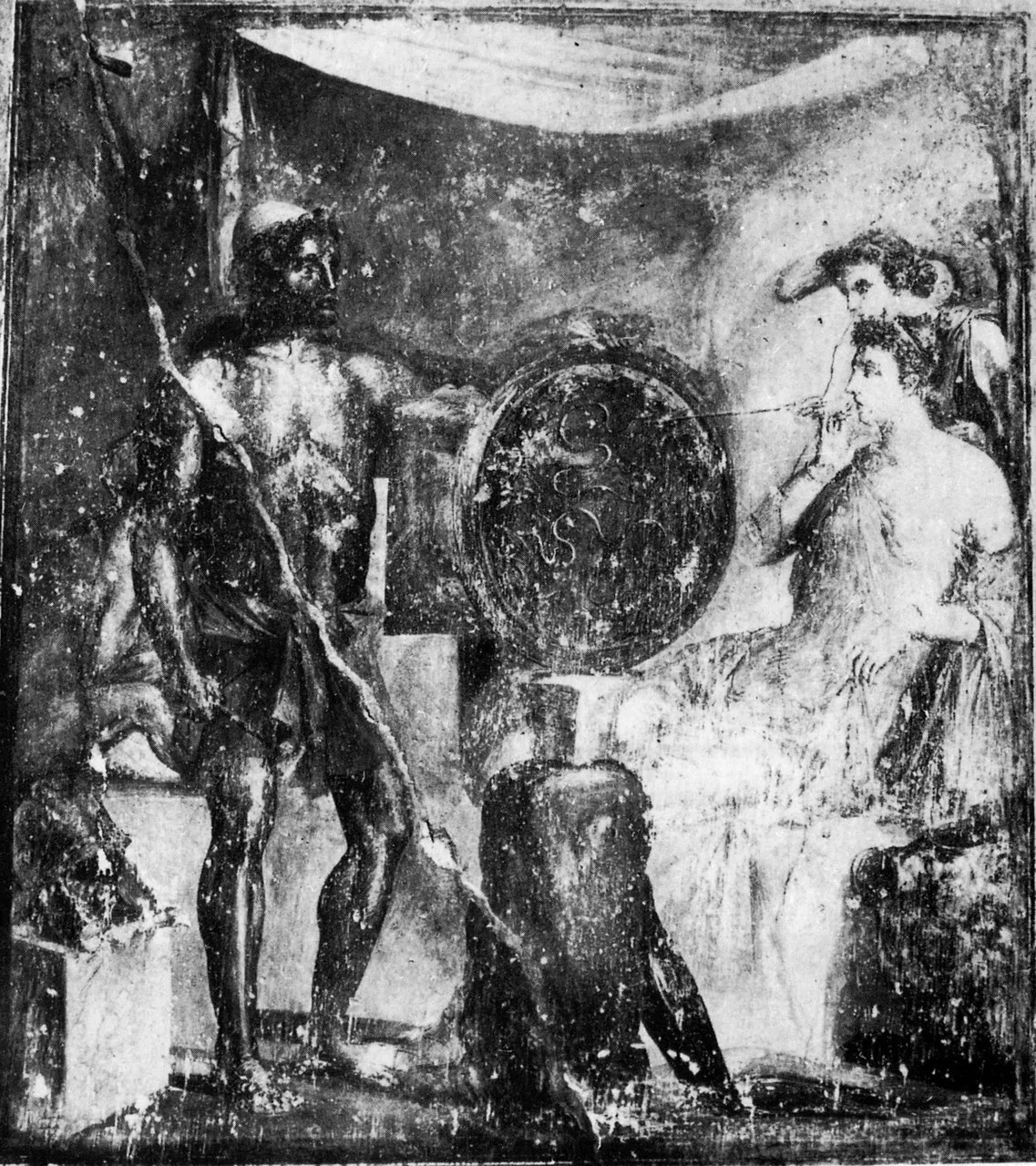
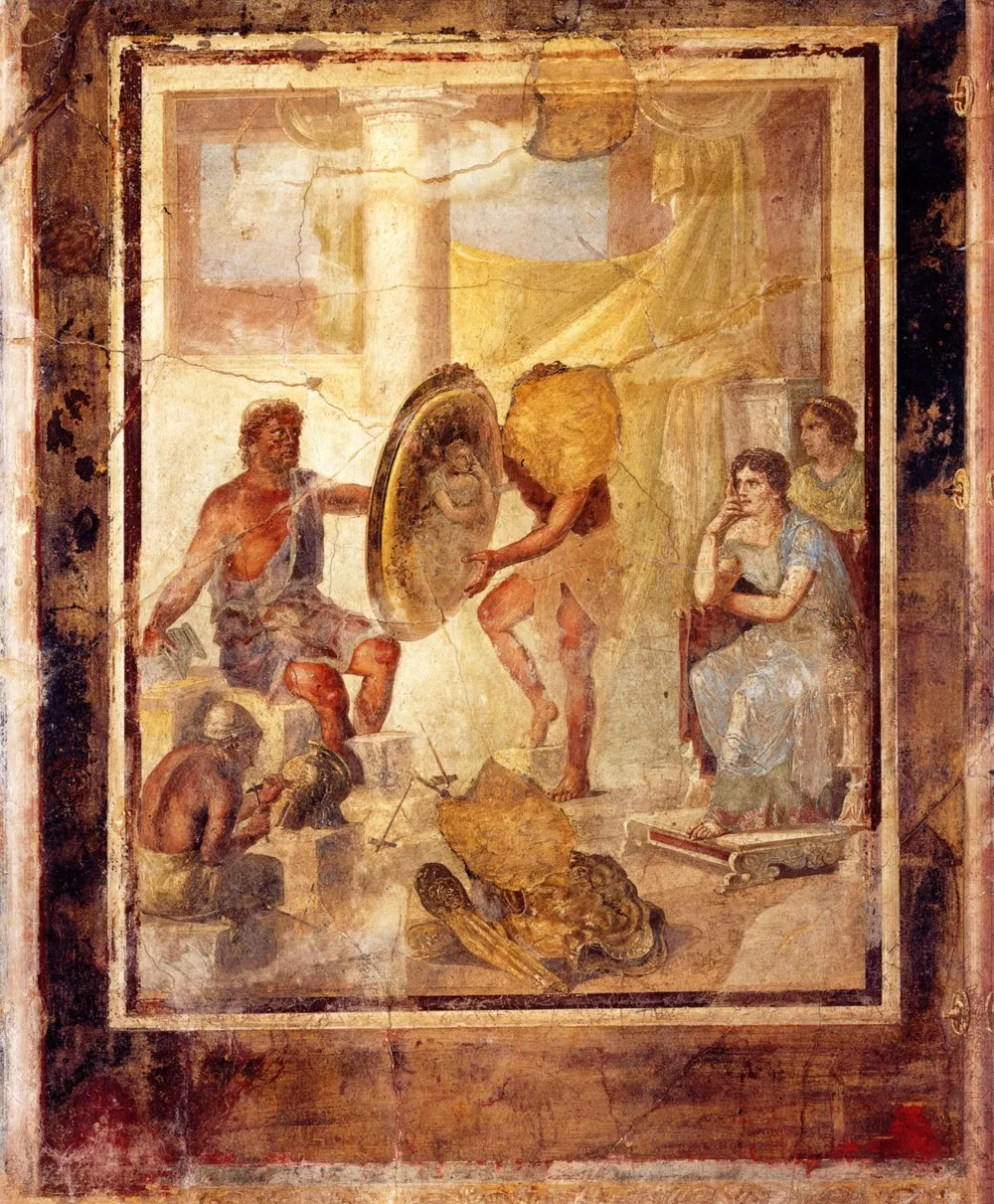
Perhaps antiquity’s most ‘wonderful’ visualization of the shield can be found in two early Imperial Tabulae Iliacae, today housed in Rome’s Musei Capitolini. These tablets give literal form to the literary vignettes of the Homeric description, making materially manifest the marvellous make-believe of the description. In the best surviving example, Homer’s «great and mighty shield» is shrunk to a miniature object of just 17.8 cm in diameter.
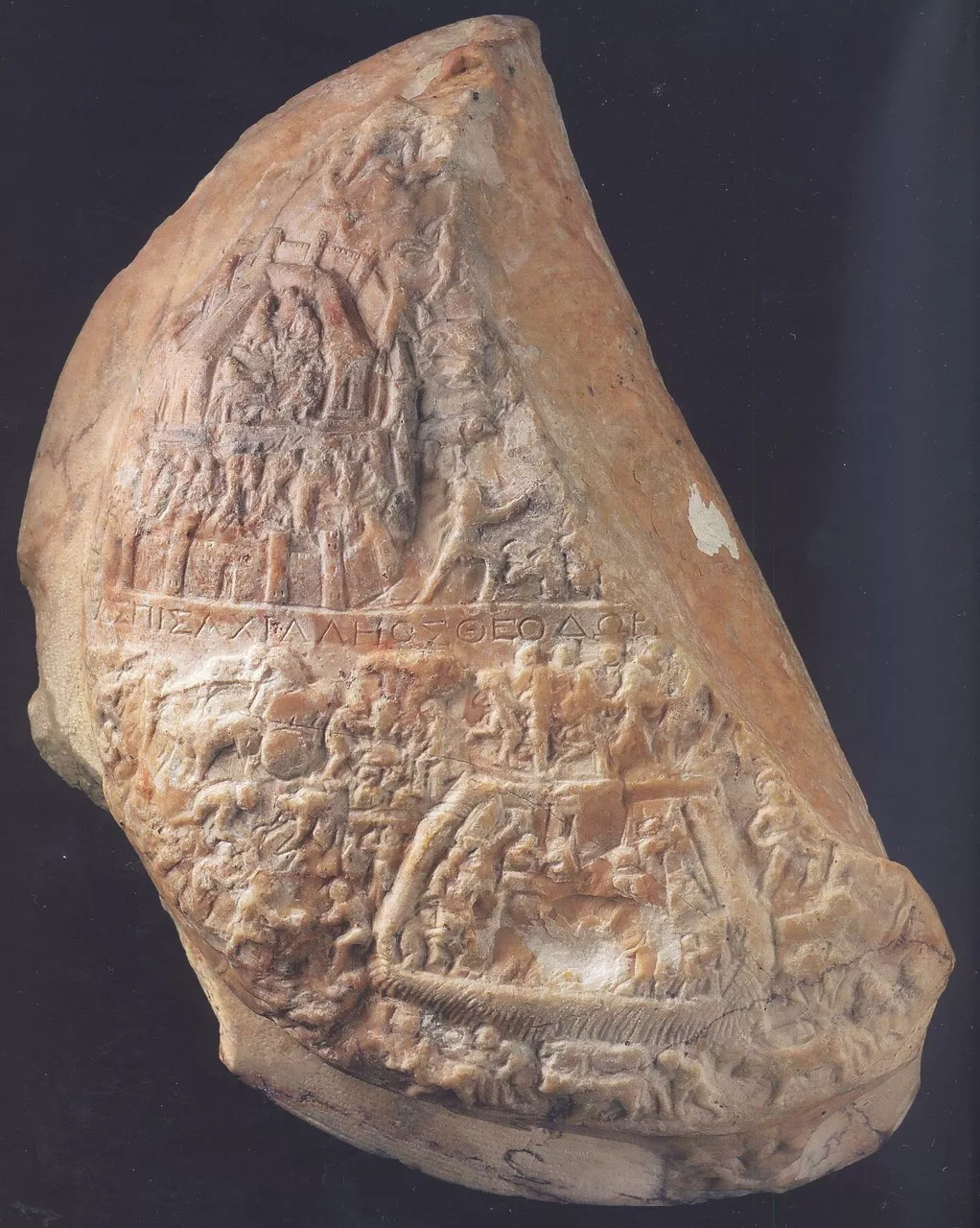
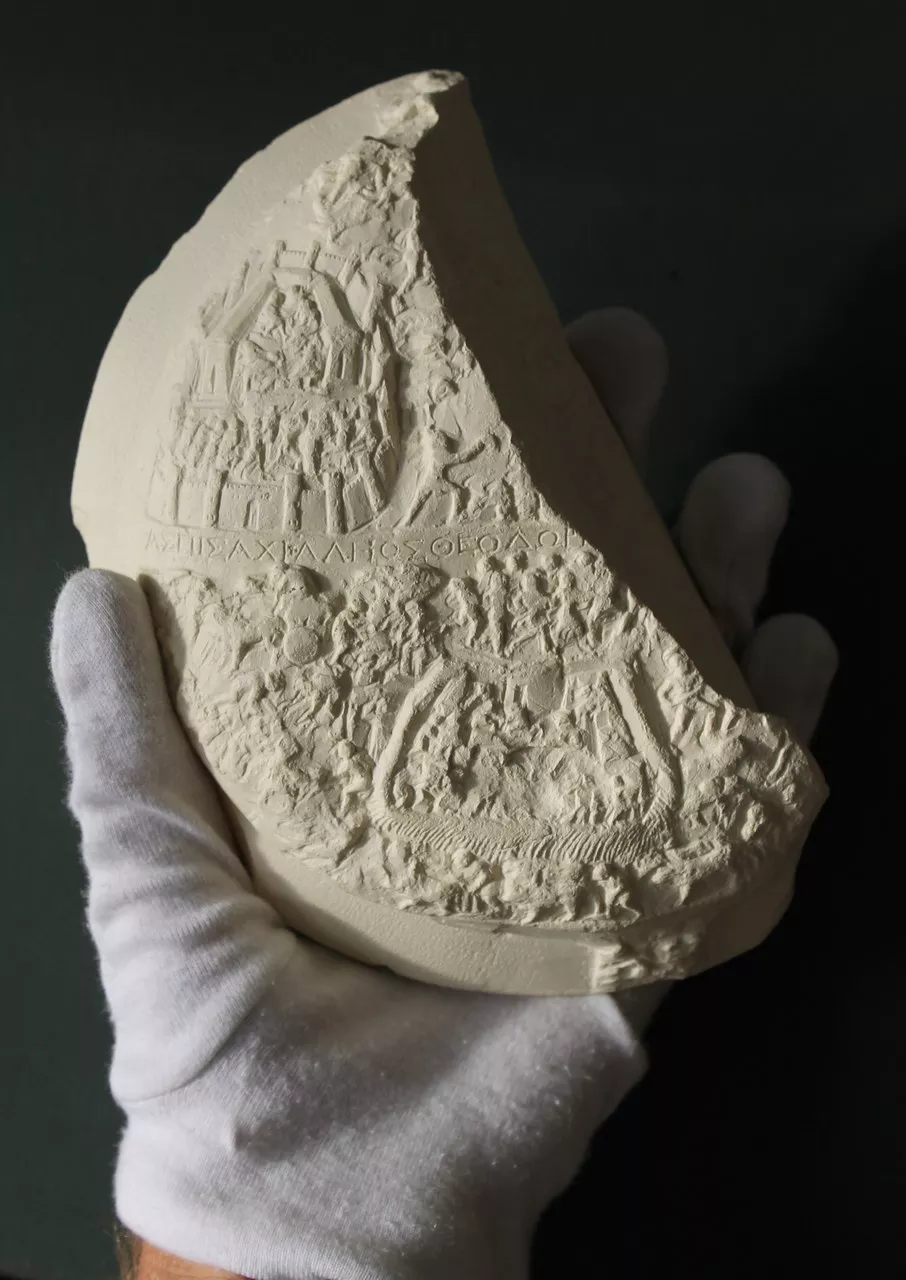
Despite its diminutive scale, the outer rim of the tablet also provides a transcription of the entire span of the Homeric text, written in letters less than 1 millimetre in height – just about visible, in other words, but barely lisible.
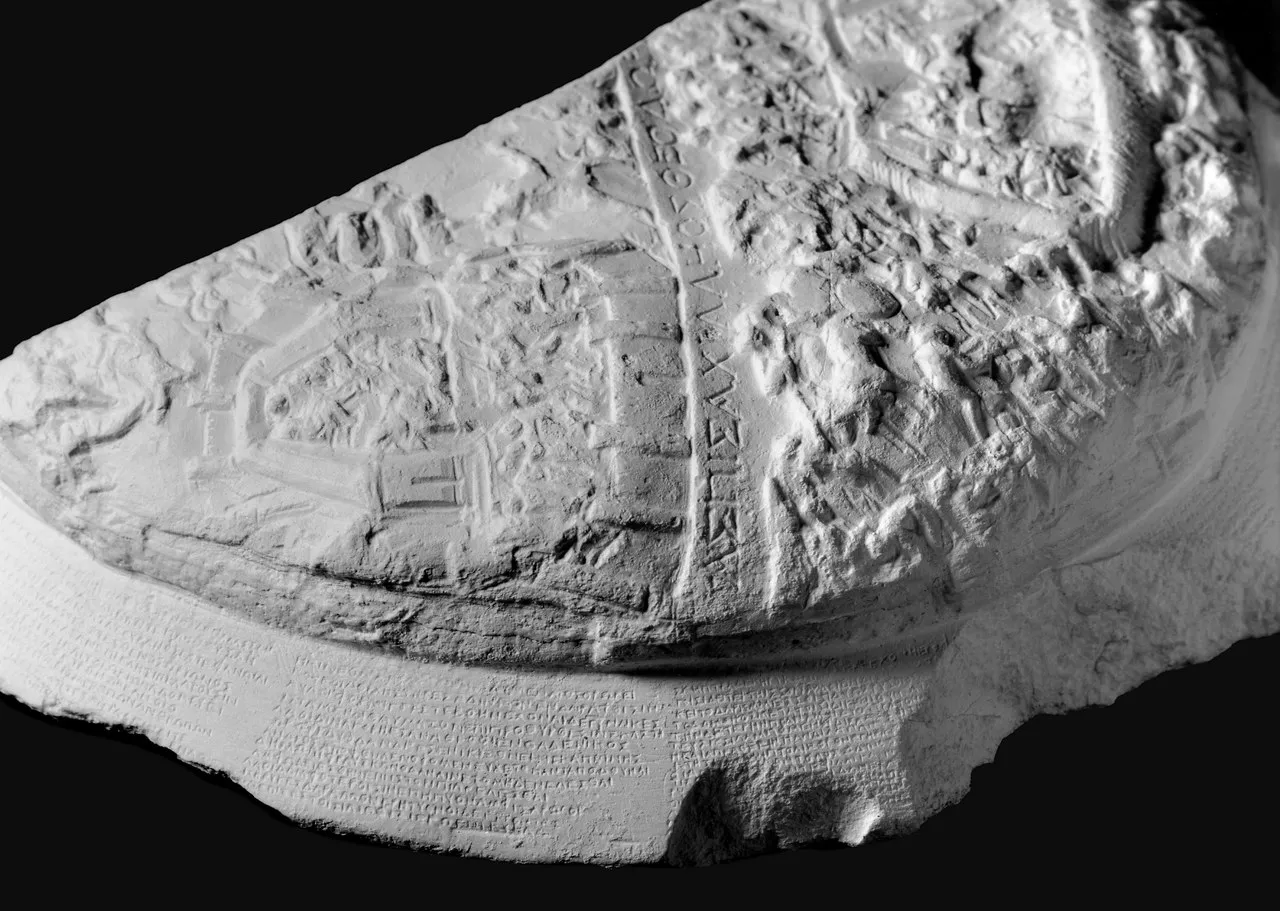
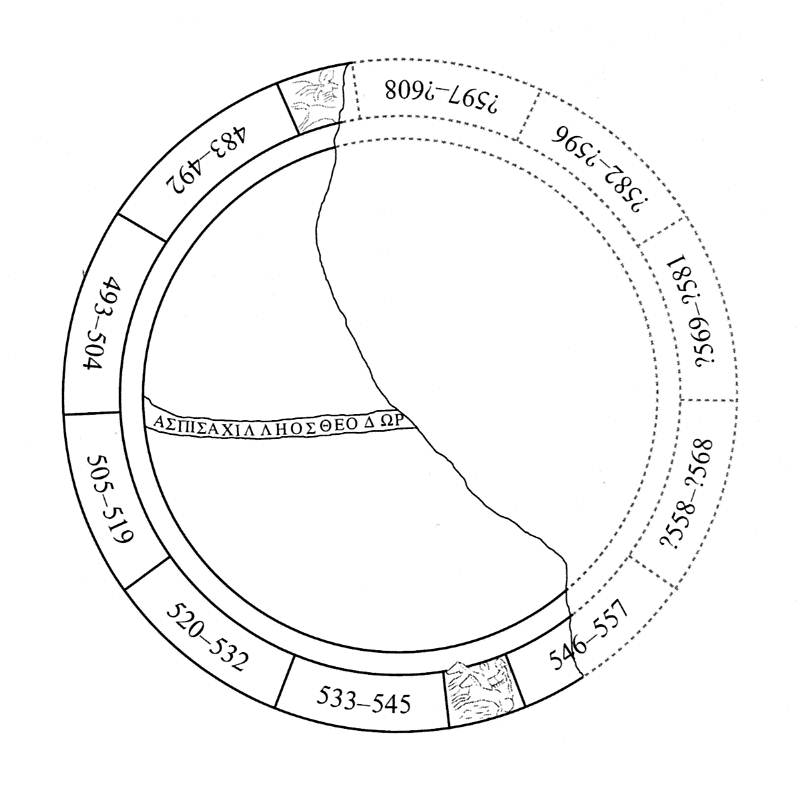
The replicative play here is astounding. In a literal and metaphorical sense, the graphic presentation of the Homeric ekphrasis continues the circle from image to text and back again: just as the Homeric description moves from object (Hephaestus’ shield) to poem (the ekphrasis of book 18), we also move here from image (the visualization of that verbal portrayal) back to text (the verbalization of that visual portrayal); this text is a verbal representation of a visual representation of a verbal representation of the visual representations of (and indeed in) the shield! Like the radiating bands of Homer’s cosmic description, encompassed in the described image of the shield, all of these replicative levels are monumentalized within the combined visual-verbal parameters of the tablet. But does the poem verbalize the object, or the object visualize the poem? Which comes first – the verbally-visualized text, or the visually-verbalized image? Is the ‘original’ object a text for reading, or an object for viewing…?
F.P.: What amazing examples! They seem to enact all the complexities of the relationship we are discussing in their own material form, as it were – as objects for reading or for viewing, or indeed for both. In particular, it’s striking to see how the dynamic interactions between the verbal and visual intersect with those of the little and large (I’m thinking, of course, of Stewart 1993). I guess the point takes us back to the genre of epigram. An object like your ‘Shield of Achilles’ Tabula Iliaca confers a sort of ‘epigrammatic’ quality to the objects, and in deeply self-referential ways. As you have argued (Squire 2011: 87-126), the Tabulae Iliacae themselves integrate epigrams into their material forms – they are self-consciously both literary texts and physical objects. Can you say a little more about how this fits against the generic backdrop of ancient epigram itself?
M.S.: Well, such self-referentiality inheres in the genre of ancient epigram. By definition, ‘epigram’ is something inscribed – ‘written onto’ a material object. When from around the fourth century BC, epigrams come to be anthologized in literary collections – and when they come to be written as expressly ‘literary’ feats, removed from any material referent – they play knowingly with that medial remove: they maintain their references to ‘this’ or ‘that’ aspect, but they are well aware of the fictitiousness of such deictic claims. Games of voice come to the fore too (there’s a wonderful study in Tueller 2008): one thinks, for example, of how some epigrams stage the interpretation of the missing artwork as a dialogue between the poet/reader and the ‘talking’ image.
How does that ancient intellectual backdrop resonate with your Renaissance materials?
F.P.: Very productively, I would say! I can think of many cases in which the visual and object-like quality of the epigram as a form interacts with a distinctive emphasis on voice – an interaction that evokes the missing object while interrogating the medial identity of written texts. Recently I have started working on prose rubrics introducing short lyric texts as a form of paratextual self-commentary. In my research, I aim to consider also the ‘internal’ frames of texts, that is to say the internal subdivisions of the poems, by which it is at times possible to identify a ‘text within the text’ (Pich 2016). Most commonly, this happens when a different voice is introduced to speak the final verse of a sonnet or some lines are identified as a text allegedly to be engraved on a tomb or pedestal. However, at times the rhetorical set-up of a poem invites the reader to consider the whole text as ‘inscribed’ or ‘engraved’, and to become a viewer.
One example that comes to mind is the penultimate text in a fascinating cycle of seven sonnets (Tebaldeo 1989-1992, II/1, 223-229) written by the Ferrarese poet Antonio Tebaldeo (1463-1537) for the Beatricium; the Beatricium was a collection of poems promoted by Ambrogio Leone around 1493 to celebrate the portrait bust of his beloved, Beatrice de’ Notari (which the sculptor Tommaso Malvito was commissioned to execute). The poetic project was never completed, but a significant number of texts by various authors have survived (Pich 2008a: 157-167). In the opening sonnet of Tebaldeo’s sequence (sonnet 223), the almost-living presence of the statue is suggested through its own speaking voice («Che guardi e pensi? Io son di spirto priva»: «What are you thinking while you stare at me? I am without spirit»), while in sonnet 228 a similar effect is achieved by the use of the deictic («Costei che…miri»), the verbs conveying the action of looking («miri», «vedrà»), and the direct address to the viewer («pensa, spectator»). Here is the text in full, and we could imagine it as engraved below the bust (Tebaldeo 1989-1992, II/1, 228):
Costei che viva in bianco sasso miri
sculpir fece Leone: e a ciò fu spinto
perché, quando sotterra il corpo extinto
sia de Beatrice, anchor Beatrice spiri;
e perché sian scusati i soi desiri,
ché chi in pietra vedrà tal volto finto
dirà: “Non è mirabil se fu vinto
Leon, se visse in lacrime e in sospiri!”.
Hor pensa, spectator, se l’amò forte,
quando pose ogni studio, ogni valore,
in dar la vita a chi gli die’ la morte!
Una ha in marmo, una in carte et una in core;
restaranne una, se fien l’altre morte:
lui una, una Malvico, una fe’ Amore.
Of course these and other similar possibilities can trace their ancestry back to classical poetry – above all to ancient epigram (and ancient epigrams on portraits), whose features transmigrate in the Italian tradition into different forms (the quatrain, the sonnet and the madrigal).
M.S.: Yes, they go back to that idea of the ‘speaking’ portrait, don’t they? One of my favourites is this epigram attributed to the female poet Erinna (AP 6.352 = Erinna 3 G-P; cf. e.g. Männlein-Robert 2007a: 38-43; Tueller 2008: 142-143; Squire 2011: 238-239).
ἐξ ἀταλᾶν χειρῶν τάδε γράμματα· λῷστε Προμαθεῦ,
ἔντι καὶ ἄνθρωποι τὶν ὁμαλοὶ σοφίαν.
ταύταν γοῦν ἐτύμως, τὰν παρθένον ὅστις ἔγραψεν,
αἰ καὐδὰν ποτέθηκ’, ἦς κ’ Ἀγαθαρχὶς ὅλα.
This painting/writing [grammata] is the work of delicate hands. Most excellent Prometheus, there are humans as clever as you! At least if the person who so accurately depicted/wrote [egrapsen] this girl had only also added a voice, you would be Agatharchis complete.
With the talk of grammata and graphein – referring to the strokes of both writing and painting – the poet blurs the lines between the two media. But Erinna also capitalizes on that essential difference of voice – as a way, of course, in which poetry can itself speak back to painting!
F.P.: With that idea of ‘speaking portraits’, let me ask a different question. One thing I’ve also become interested in is the topic of visual poetry – of Renaissance verses that themselves literally figure the objects to which they refer: as the likes of Higgins (1987), Dencker (2011) and Ernst (2012 and forthcoming) have demonstrated, visual poetry is a phenomenon that is widely attested in several cultures, and from antiquity to the present day. I know you have written about this, and in the context of ancient ‘portrait’ picture-poems specifically (Squire 2016b). But can you say something first about ancient traditions of ‘calligrams’ more generally – about so-called technopaegnia, or carmina figurata? How did ancient visual poetry figure an identification between poem and object – the double nature of text as picture (and vice versa)?
M.S.: Well, amid the Greek poems of the Palatine Anthology, six such examples survive (Anth. Pal. 15.21–22, 24–27): three are attributed to Simmias of Rhodes, and probably date to the early third century BC (showing the ‘wings of Eros’, an ‘axe’ and an ‘egg’); a fourth poem in the shape of panpipes was mistakenly attributed to Theocritus, and two show altars (both Roman Imperial in date, attributed to Dosiadas and Besantinus respectively). In each case, the shape of the lines summons up an iconic artefact (the most detailed study is Kwapisz 2013; for my own thoughts, see Squire 2013c).
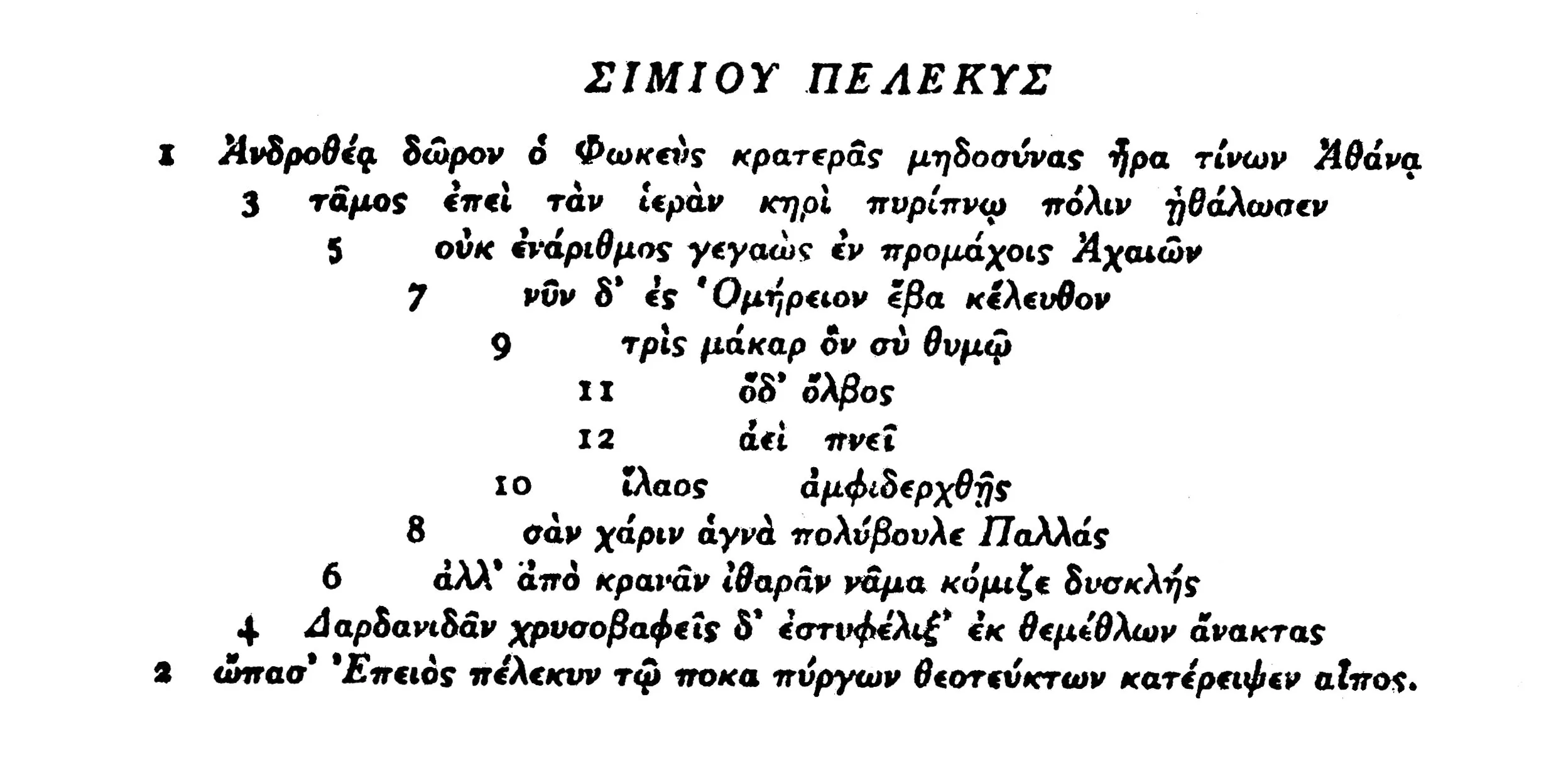
In the case of Besantinus’ altar, the game is further played out through the addition of an acrostich – a text running down the left-hand side of the altar, and inscribing it with the exhortation, «Olympian, may you sacrifice for many years!» («Ὀλυμπιε, πολλοῖς ἔτεσι θύσειας»).
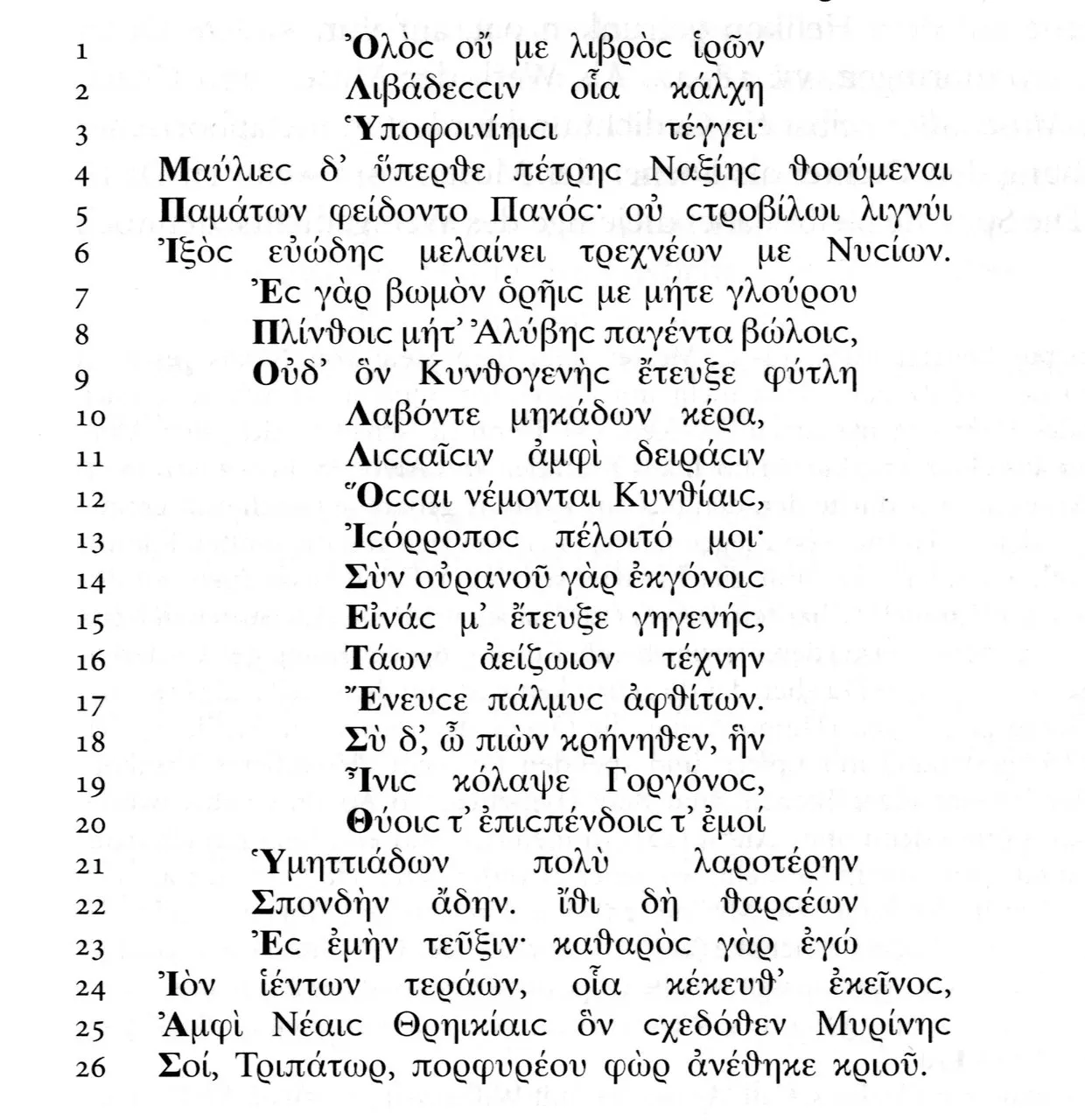
I guess these sorts of acrostichs offer a parallel for the ‘text within the text’ that I know you’re interested in – although of course, we’re here dealing with a text within a picture within a text!
One of the things that interests me about such calligrams is their play upon the standard tropes of epigram. Here, the very ‘textuality’ of the poem is used to summon up the material platform that literary epigram has denied them.
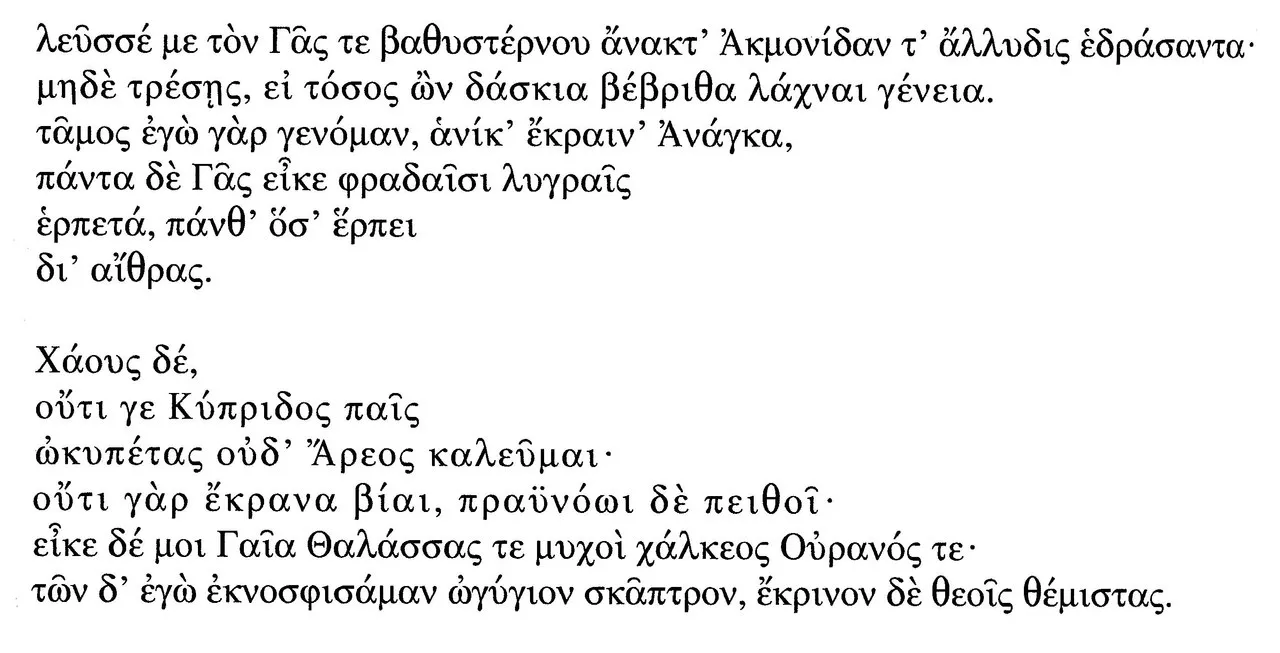
When Simmias’ poem on the ‘Wings of Eros’ begins with the exhortation to «look upon me» («λευσσέ με»), it trades upon the standard epigrammatic exhortation to ‘look’, as well as the speaking or ‘ventriloquist’ first-person voice. Here, though, we really can hope to ‘see’ the image referred to: in a mise-en-abyme of replications, the speaking first person of the epigram refers at once to the god Eros himself, his statue, its calligrammatic image, the dedicatory inscription attached to it, and the papyrus scroll that represents all of these levels and more.
I know these sorts of poetic conceits are paralleled in the Renaissance materials that interest you. But I guess one difference between our fields of study lies in the transmission of the poems. With your materials, I suspect you can in most cases be confident about their ‘original’ modes of presentation. With the poems I’m discussing, by contrast, we know of the texts only from much later manuscripts: we’re not sure about how they were originally written out. In that connection, it’s interesting that, in the case of Simmias’ other two picture-epigrams (Anth. Pal. 15.22, 27), the lines that make up the iconic shape only make semantic sense when readers physically unscramble their sequence of increasing and decreasing choriambic verses. Readers, in other words, had first to tackle the opening line, then the last (followed by the second, and then the second-to-last, etc.), thereby undermining the figurative appearance of the calligram as they read it: just as seeing the picture meant reordering the poem, reading the poem entailed collapsing the picture. Alternatively, perhaps we should imagine the reverse scenario: maybe the poems worked like logogrammatic riddles, their physical appearance disguised by their original more prosaic appearance. In which case, the games must have proceeded the other way round: readers had quite literally to ‘figure out’ the picture from the clues latent in the unfigured poem, drawing the picture, and captioning the poem (‘Egg!’, ‘Axe!’).
F.P.: This brings me to your recent interest in the late-antique Latin poet, Optatian (e.g. Squire 2011: 216-228; Squire 2015a; Squire 2016a; Squire and Wienand 2017). How did your research come to cross Optatian’s work? And could you briefly introduce him?
M.S.: Yes, I got interested precisely in graphic forms that combine the verbal and the iconic. This interest took me to graffiti that arrange their letters into a pictorial schema (into a portrait, for example – or into a ship; cf. Langner 2001).
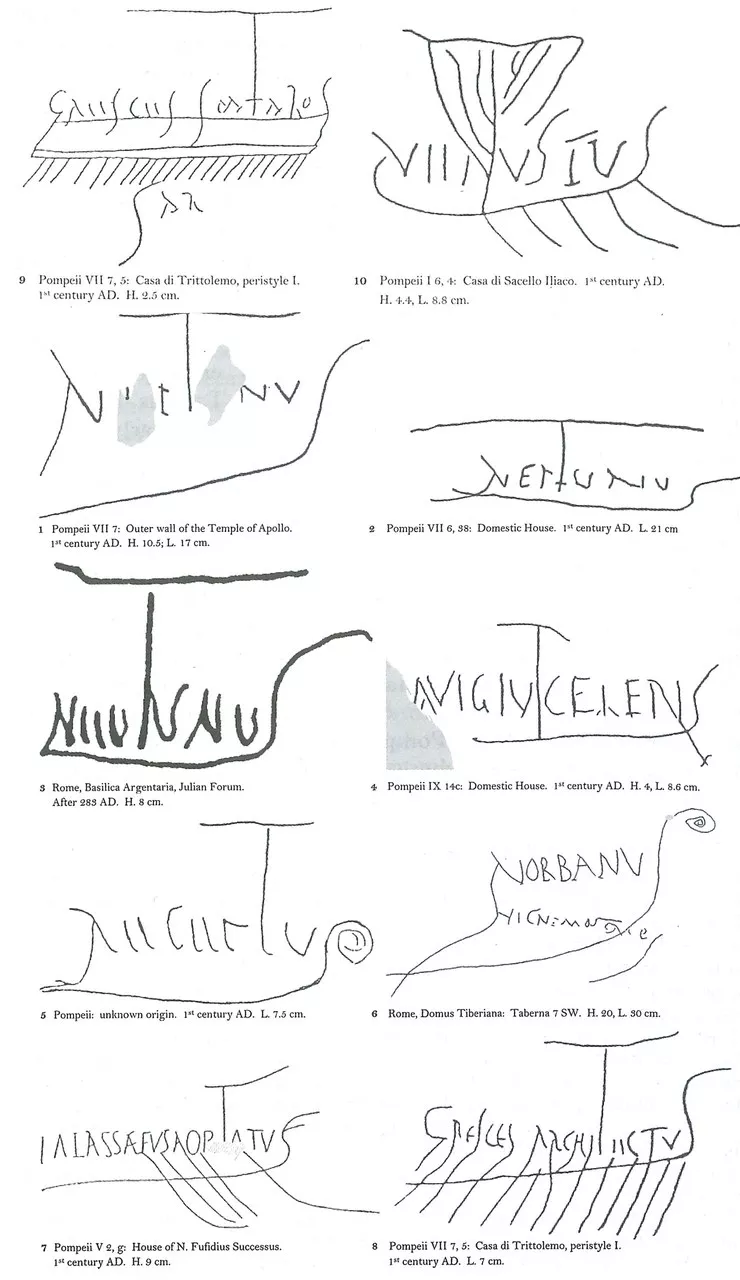
It also took me to inscribed verses from Pompeii – two suitably serpentine couplets on ‘snake games’, for instance (CIL 4.1595 / CLE 927): cf. e.g. Wojaczek 1988: 248-252; Squire 2014: 402-403).
Optatian – or to give him his full name, Publilius Optatianus Porfyrius – was one other such happy accident. I first came across him in trying to find parallels for the so-called ‘magic squares’ on the back of seven of those Tabulae Iliacae that I’ve already mentioned.
![Reconstruction of the ‘magic square’ on the reverse of two early Imperial Tabulae Iliacae (left – New York, Metropolitan Museum of Art, inv. 24.97.11; right – Paris, Cabinet des Médailles, Département des Monnaies, Médailles et Antiques, Bibliothèque Nationale de France, inv. 3118). Starting from the central iota, the text reads Ἰλι]ὰς Ὁμήρου Θεοδώρηος ἡ{ι} τέχνη (‘The Iliad of Homer: the art [techne] is Theodorean’). (Reconstruction by M. J. Squire) Reconstruction of the ‘magic square’ on the reverse of two early Imperial Tabulae Iliacae (left – New York, Metropolitan Museum of Art, inv. 24.97.11; right – Paris, Cabinet des Médailles, Département des Monnaies, Médailles et Antiques, Bibliothèque Nationale de France, inv. 3118). Starting from the central iota, the text reads Ἰλι]ὰς Ὁμήρου Θεοδώρηος ἡ{ι} τέχνη (‘The Iliad of Homer: the art [techne] is Theodorean’). (Reconstruction by M. J. Squire)](http://www.arabeschi.it/uploads/xpich-squire_conversationintemedialities_i_fig10.jpg.pagespeed.ic.Xt41VdthNj.webp)
On the reverse side of these tablets, letters are arranged in a grid; to read the inscribed text, one has to proceed from the middle letter and work outwards to any of the four corners; the viewer-reader can vary the direction of reading as s/he does so – so that the very act of response breaks free from the linearity of written text (cf. Squire 2011: 197-246).
Although his poems work differently, Optatian likewise relies on the gridded arrangement of his letters. Like the artists of the Tabulae Iliacae, Optatian is also interested in the boundaries between words and pictures. Optatian himself was writing under the Emperor Constantine in the fourth century AD (primarily, it seems, the 310s and 320s): in all, around thirty poems are known – meticulously presented in an edition (complete with Latin commentary) and Italian translation by Giovanni Polara (Polara 1973; Polara 2004). Despite his popularity in the Carolingian world (cf. Ernst 1991), Optatian has found few friends among recent scholars: «the text itself is devoid of all interest save its curiosity, paying witness to the decadence of an art and a culture», as one twentieth-century assessment puts it; in another response, he has been deemed the «author of hare-brained frivolities in verse [der Verfasser hirnverbrannter Versspielereien]», astonishing scholars as to how «a man wanted to squander his days in such laboriously contrived affectations» [ein Mann so unendlichen Fleiss auf solche Abgeschmacktheiten und Nichtigkeiten verwenden wollte]. Predictably enough, I see things differently…
So what do Optatian’s poems look like? In three examples – dubbed ‘images of metres’ or imagines metrorum (Carm. 26.23) – Optatian exploits the figurative frame of each poem to figure the mimetic outline of the objects evoked: a water-organ (Carm. 20), altar (Carm. 26) and a set of panpipes (Carm. 27).
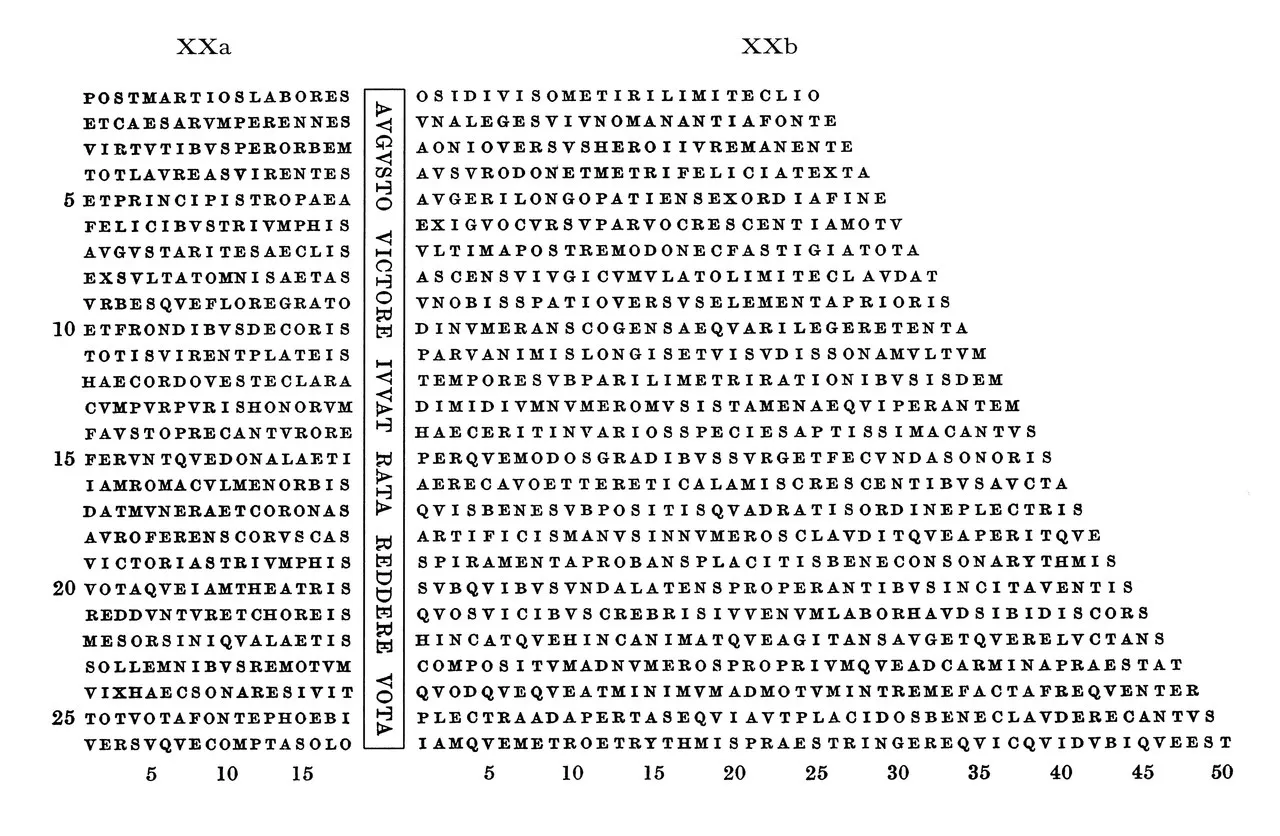
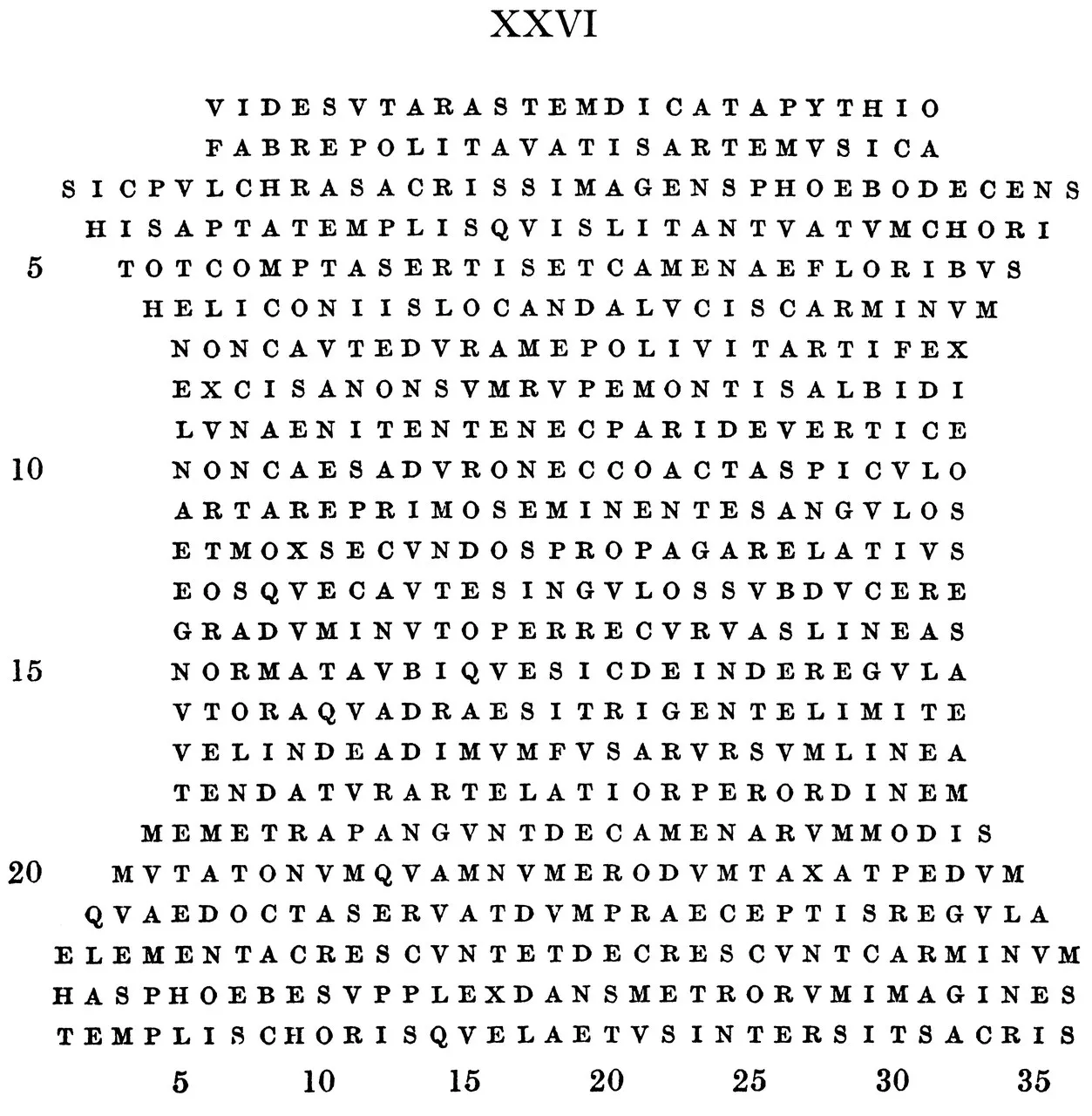
While adopting the working principle of their Hellenistic and Imperial Greek predecessors, these poems nonetheless adapt their models. Where Greek poets had used metrical variations to draw out their pictorial forms – lengthening and shortening the number of metrical units in each verse – Optatian uses the quantity of letters: each letter is placed within a single box, and the boxes are laid out in a gridded pattern to make up the shape of their visual referents. So it is, for example, that the isometric hexameter verses of Carm. 27 reduce the number of alphabetic units as they proceed down the page (from 42 letters in the first verse to 28 in the last), thereby summoning up the image of panpipes. A similar variation renders the more complex shape of an ‘organ’ in Carm. 20 – this time comprised from two poems, each of 26 verses, sandwiched either side of a single hexameter: where the left-hand poem (Carm. 20a) is written in catalectic iambic dimeters, with eighteen letters in each verse, the right-hand hexameter poem (Carm. 20b) rises from 25 letters in v. 1 to 50 letters in v. 26, thereby inverting the declining numerical scale of Carm. 27.
In other poems, Optatian adapts this ‘gridded’ approach to language in still more innovative ways.
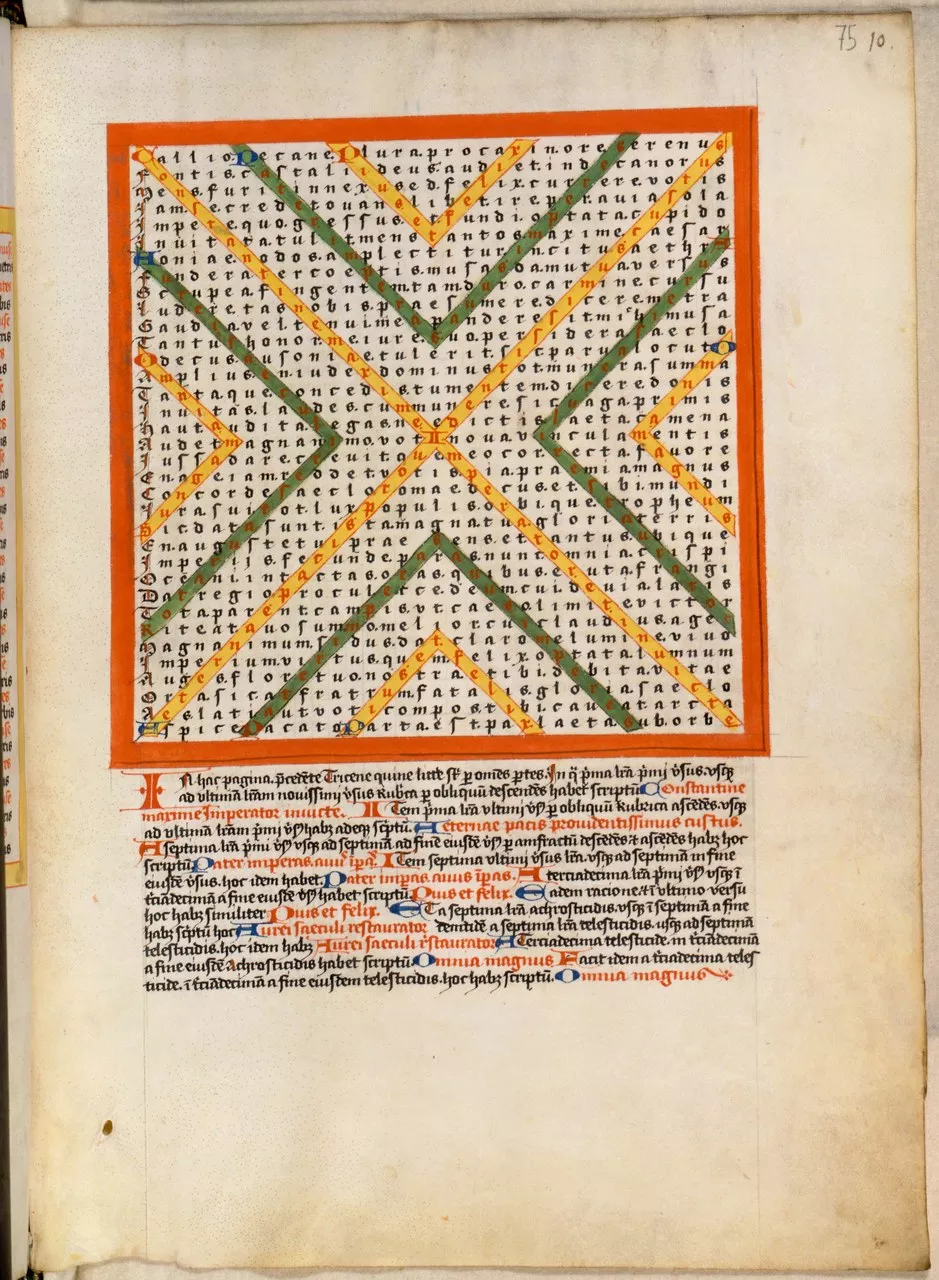
Treating the textual fabric of the poem as a grid, he transformed the space within each self-standing poem into a sort of two-dimensional ground against which to figure internal patterns. In all, sixteen such grid-poems have been ascribed to Optatian (Carm. 2, 3, 5, 6, 7, 8, 9, 10, 12, 14, 18, 19, 21, 22, 23, 24); most often, the poems make up a grid of 35 letters across and along the horizontal and vertical axes. By marking out letters in different colours, or else using lines to draw designs within the grid, the poet redeployed alphabetical units from one context to another: apparitions are thereby figured inside the frame of each text. But those apparitions are not just optical adornments. They also add up to words, phrases and verses in their own written right: while furnishing graphic forms, the internal patterns can be read as self-standing poems; in each case, the designs are at once integrated within the ground-poem and yet adorn it with external (one might perhaps say ‘parergonal’, or indeed ‘paratextual’) critical commentaries… As such they offer another nice parallel to your previous point about ‘texts within texts’.
Optatian harnessed the internal designs of his grid-poems to various semantic ends. Sometimes the patterns add up to geometric or floral ornaments (Carm. 2, 3, 7, 12, 18, 21, 22 and 23); elsewhere, Optatian paints mimetic or schematic images – a palm-frond (Carm. 9), a ship (Carm. 19), the schematic outline of an army in quincunx formation (Carm. 6), and perhaps a shield (Carm. 7). At other times again, the marked patterns yield still more letters (and by extension numerals), now arranged as gigantic graphic forms: where Carm. 5 reveals the letters AVG. XX CAES. X (celebrating the twenty- and ten-year anniversaries of Constantine and his sons), for example, Carm. 23 can be understood to yield the letter ‘M’ (emblazoning the initial of a certain ‘Marcus’ addressed in the zig-zagging verse within); by the same logic, Carm. 8 spells out the name IESVS around a central chi-rho.
If the grid-poems oscillate between figurative, ornamental and alphabetic forms, they also blur the distinctions between such significatory modes. Quite apart from the chi-rho ‘christograms’ of Carm. 8, 14, 19 and 24 (which integrate a combined symbolic and alphabetic design, and one that unites both verbal and visual patterns of significance), one thinks of Optatian’s penchant for criss-crossing ‘X’-shapes (perhaps nowhere more spectacularly than in Carm. 10)…
Whatever one makes of these texts as ‘poetry’, I am in awe of the philological and metrical skills required. Are there any parallels in the materials you’ve been studying?
F.P.: Those ‘magic-square’ inscriptions – as well as Optatian’s grid-poems – remind me of a much later inscribed grid, which appeared in Ercole Tasso’s Virginia (Tasso 1593a) and, later in the same year, in his Poesie (Tasso 1593b).
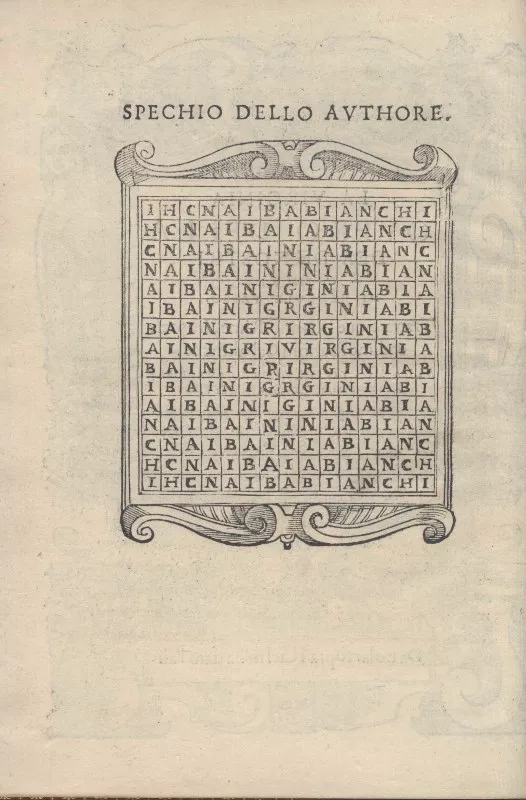
La Virginia overo della dea de’ nostri tempi. Trattato ove si hanno Rime, Imprese e dimostrazioni Cabalistiche is a complex system made up of 24 sonnets, 13 cabalistic mysteries in prose and 12 imprese plus a final one (Maggi 1995, 1998 and 2006; Benassi 2008), all revolving around the name of the beloved lady, Virginia Bianchi, and most probably inspired by Maurice Scève’s Délie (1544). The arrangement of the Poesie into three libri including respectively verse (I), prose (II), and verse and prose (III) dismantles the sophisticated prosimetrical and ‘iconotextual’ sequence of the original Virginia, in which sonnets are regularly placed on the right-hand page, whereas prose mysteries and imprese alternate on the left-hand page, so that «il discorso amoroso […] avvicenda una narrazione poetica a una impresistica e cabalistica» (Benassi 2008: 421).
The particular grid I wanted to mention appeared on the first left-hand page of the Virginia (c. A1v), right before the dedication letter to Giulia Albana de’ Tassi, and then in the second book of the Poesie (c. 29v), inserted between the «brievi dichiarationi» of mysteries and their actual beginning. The grid is placed within a frame and identified as the «SPECHIO DELLO AVTHORE» («mirror of the author»), with the preposition (‘dell’autore’) allowing for a semantic ambiguity between ‘mirror reflecting the author’ and ‘mirror belonging to the author’. Overall, the grid-mirror seems to reinforce the unitary interpretation of La Virginia as «nothing but Tasso’s enigmatic self-portrait» (Maggi 1995: 51), while pointing to the nature of all the following «misteri» as «‘specchi’ dei versi che li accompagnano» (Maggi 2006: 13). In the Poesie, an explanation («Dichiaratione») was added below the grid:
La V.[irginia] che, quasi centro, risiede nel mezzo di questa Tavola, è la chiave, con cui, volta a qual parte si voglia, sempre apre il nome et cognome insieme di questa Signora.
Virginia, who, as a centre, sits in the middle of this table, is the key with which, in whatever direction you turn it, [the table] always opens both the name and surname of this Lady.
In fact, each of the 225 boxes that make up the square grid contains a letter belonging to the lady’s name or surname; letters are arranged in such a way as ceaselessly to reproduce the alphabetical sequence of her name through a myriad of orthogonal paths moving outwards from the centre (just as on those Tabulae Iliacae). 24 of the 30 bands are inhabited by the partial, mirror-like replication of the name and surname, which are instead displayed in full on the two central and the four external bands respectively, therefore forming a cross and a square. For numerical reasons, the seven-letter surname disappears beyond the frame when the eight-letter name is complete (AINIGRIVIRGINIA), whereas the last letter of the name (‘A’) remains in sight even when the surname appears in its entirety (IHCNAIBABIANCHI).
M.S.: Amazing – this example is in a very closely related same tradition, and I wonder where Ercole Tasso’s idea came from. But I guess one main difference lies in medium and presentation. Where the Tabulae Iliacae are inscribed material objects (and Optatian’s poems were originally written out by hand – in what must have been lavish manuscripts, probably in the form of a codex), Ercole Tasso’s work forms part of a printed volume. How, do you think, does your example relate to a particular sixteenth-century culture of the printed book?
F.P.: Yes, the printed book is important, and there’s a stimulating bibliography here. As several studies have shown, the continuities between scribal culture and the culture of print are strong and vital (Bolzoni 1995; Richardson 1999 and 2009); but we must not underestimate the implications of the difference in media in terms of ‘iconotextual’ agency and creativity. For example, the contemporary scholar and artist Johanna Drucker (b. 1952) explained that, in her work,
the original inspiration for exploring the potential of language as a material form came from the experience of “holding language in my hands” – lines of letterpress type shaped in a compositing stick whose weight and presence were as much physical as linguistic. (Drucker 1998: 131-132).
Let me take that modern line of thinking back to Optatian. You’ve talked about the collection, but could you talk me through one specific example more closely?
M.S.: Well, my favourite Optatianic poem has to be Carm. 19 (cf. Squire 2015a), which we can illustrate via Polara’s modern typographic presentation and a sixteenth-century manuscript in Wolfenbüttel.
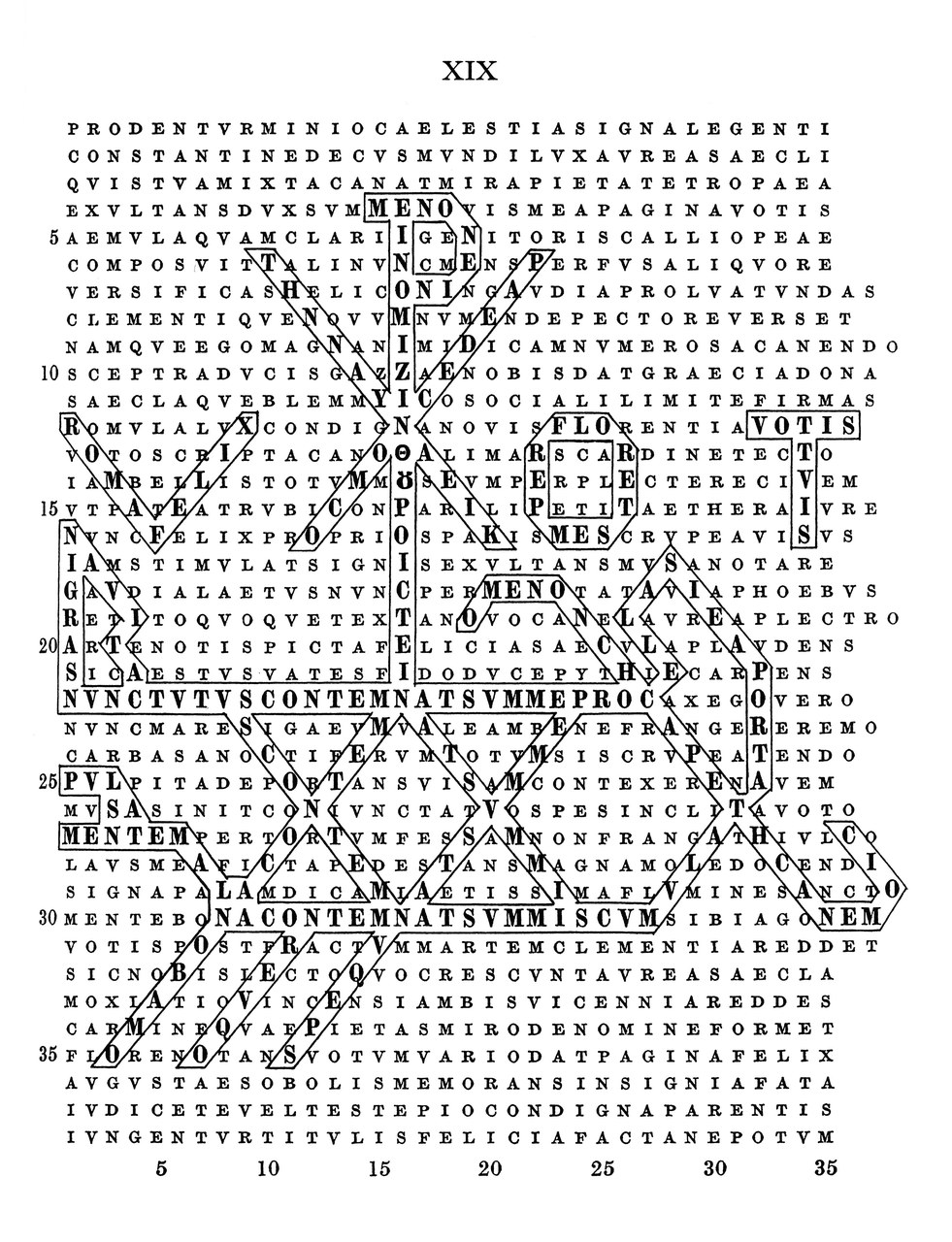
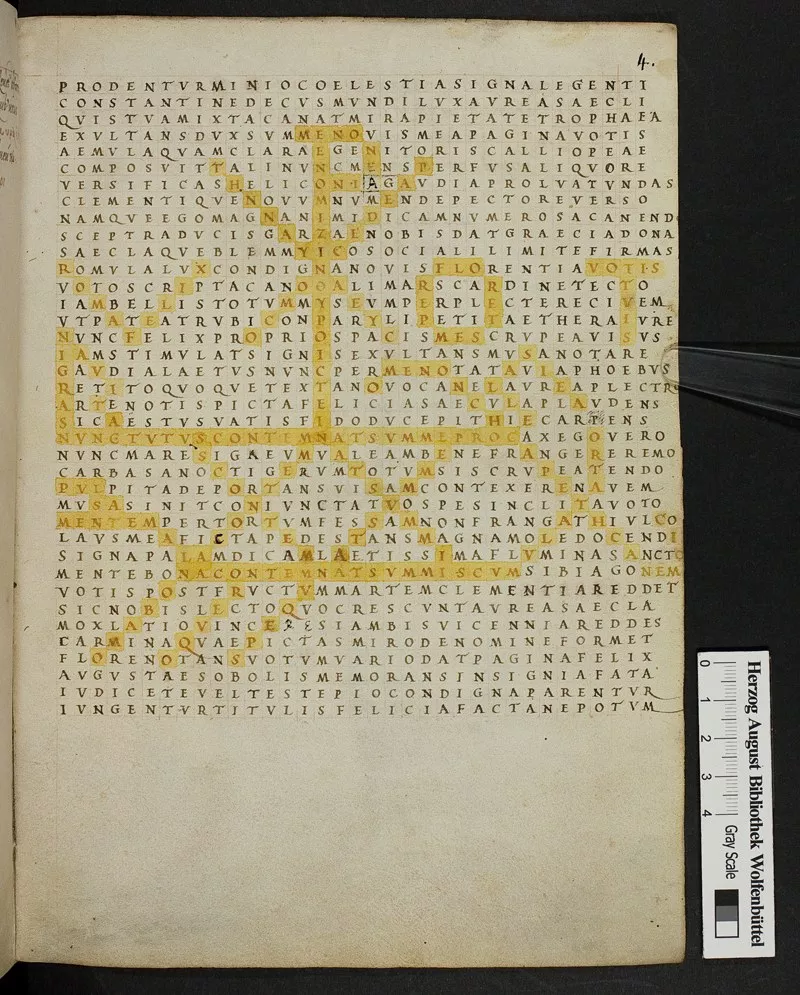
Here we find multiple visual and verbal forms combined in a single creation: on the one hand, the coloured internal letters present a ship complete with tiller, rudder, oars, ramming spike and a mast and sail in the shape of a chi-rho; on the other hand, the letters VOT are made to float above the sea, just as the ship’s hull is crafted from a numerical XX-formation (alluding to the number 20 – a reference to Constantine’s vicennalia in the year AD 326). As ever, Optatian delights in the multiple signifying work that his signs (signa) perform: «the cinnabar will reveal the heavenly signs to the reader», as the poem’s opening verse puts it («prodentur minio caelestia signa legenti», Carm. 19.1).
How does this relate to that point by (the wonderfully named!) Drucker about «holding language in her hands» – about the physical «letterpress type»? For Optatian, language is certainly ‘physical’ as well as ‘linguistic’. But the talk of signa seems to be premised on a different concept of ‘text’. Indeed, the very idea of colour (in this case cinnabar) hints at something much more painterly: all those metaphors of printerly ‘pressing’ are dependent on a very different understanding of textuality.
In poem 19, what is so staggering about all these visually combined figurative-alphabetical-numeric patterns is their simultaneous capacity to be read as poems in their own written right. The simplest message is encoded within the letters VOT (itself referring to the ‘vows’ that recur in the poem’s ground-text). We have to read in a variety of directions, of course – horizontally, vertically, diagonally, even around a never-ending ring (the letter ‘O’ that appropriately heralds the words floret semper in a continuous circle). Put the pieces together from left to right, though, and we end up with the following: Roma felix floret semper uotis tuis («blessed Rome always flourishes under your vows»).
The letters figuring the mimetic outline of the ship comprise something still more remarkable. In line with the figurative image of the ship, readers can here embark upon a variety of different itinerant journeys. Beginning with the N which opens v. 16, for example, one option is to navigate a reading that moves vertically down and then horizontally across the grid, proceeding from the top of the prow to the top of the stern. The result is a hexameter, and one which overtly develops the naval theme: nigras nunc tutus contemnat, summe, procellas («let him now defy the black storms in safety, o great one»). Another possible ‘navigation’ might instead begin with the zigzagging word nauita. If we start with this dactyl (instead of the spondee nigras), we can continue in the same direction, arriving at a related hexameter, and one which specifies its subject: nauita nunc tutus contemnat, summe, procellas («let the sailor now defy the storms in safety, o great one»). Still other poetic variants to be created from the ship’s picture. A third option is to begin the hexameter neither with nigras, nor indeed with nauita, but instead with the word tutus in v. 22: if we then allow ourselves to take a diversion via either one of the criss-crossing symmetrical ‘X’ letters, we end up once again at the ship’s stern – and with a different corresponding verse (albeit one ending up with the same letter ‘S’ in v. 17): tutus contemnat summis cumulata tropaeis («let him defy in safety even that which is piled high with greatest trophies»). Alternatively, of course, we might begin lower down, with the make-believe ramming-spike at the ship’s prow (v. 25): if readers trace a path up either one of the ‘X’ letters, they once again trace a hexameter: pulsa mente mala contemnat, summe, procellas («with ill intent cast aside, o great one, let him defy the storms»). At the same time, there is always the option of instead proceeding from the ship’s outer oars. From a semantic point of view, these figurative letters may at first look nonsensical (read the lines from left to right and we arrive at a puzzling OMABONOQUERNSPEQN). But as audiences figuratively shove and heave in their efforts of viewing/reading, they eventually strike upon a hexameter: if the reader instead moves from right to left (following the ship’s own imagined course of motion), and likewise from imagined sea to hull, he finds spe quoque Roma bona contemnat, summe, procellas («with good faith, let Rome also defy the storms, o great one»).
Whichever poetic-pictorial itinerary we choose, our response to this poem must in turn navigate between different representational registers. Optatian begins his poem by talking about signa, returning to the same language in vv. 17 and 29 (signis, signa … laetissima; compare also the reference to the insignia fata of Constantine’s descendants, themselves arguably ‘signalled’ in the naval picture). And yet the ‘signs’ of this poem take on numerous forms, occupying a visual-verbal spectrum that stretches from the mimetic to the symbolic and back again, always figured through the literal arrangements of its letters. If words do double duty here as images, those images can also be read as words: this holds true of all the hidden verses which make up the poem’s figurative characters, but especially so of the words concealed in the alphabetical shapes VOT and XX. In each case, we are made to experiment with different modes of verbally interpreting the visual patterns, and of visually interpreting the verbal words: responding to these fabricated signa means thinking, in every sense, ‘outside the box’.
Perhaps most remarkable of all is the chi-rho that makes up the ship’s mast and sail. To read the textual picture is to be faced with a semantic problem: wherever we start within this ‘christogram’, and however we proceed, the visual pattern at first yields no sensible verbal message. Try out an alternative pictorial-poetic strategy, though, and it is possible to see things quite differently. We should remember that, at its most literal level, this monogram (sandwiched between the pictographic Latin text VOT) refers to something in Greek: for all its iconic fusion of the two letters, the emblem brings together a Greek chi and rho, embroidering two Greek alphabetic forms into the Latin fabric of the poem. What happens, then, if we try reading the text of the chi-rho not in Latin, but rather in Greek? Needless to say, we have first to convert the Latin letters into their Greek visual ‘equivalents’: ‘A’ doubles up as alpha and delta, for example, ‘C’ as sigma, ‘H’ as eta, ‘T’ as both theta and tau, ‘P’ as rho. As we proceed with this conversion, and continue with the letters that make up the rudder, the text changes before our very eyes, comprising a Greek elegiac couplet:
τὴν ναῦν δεῖ κόσμον, σὲ δὲ ἄρμενον εἰνὶ νομίζιν
θούροις τείνομενον σῆς ἀρετῆς ἀνέμοις.
One must think that the ship is the world, and that you are the hoisted rigging, tautened by the strong winds of your virtue.
Miraculously translated from text to image (and in turn from image back to text), and simultaneously converted from Latin hexameters into Greek elegiac couplet, these words offer an additional commentary on the ‘celestial signs’ of the lettered picture. At the same time, the text calls upon readers to interpret the picture in a different way, transforming the mimetic image of the ship into an allegory replete with other semantic connotations. Although the image of the sail and rudder stands before us, its cryptic text figuratively ‘steers’ audiences in a more (or rather less?) figurative interpretative direction: the trick, as it were, is to ‘un-see’ the picture – to ‘consider’ (νομίζ<ε>ιν) the literal image in a more intellectual sense. Within the self-contained cosmos of this poem, the couple instructs, is an imagined image of the cosmos itself, one to be seen not with physical eyes, but instead through the mental eye of our imagination; likewise, the various violent winds (procellas) hidden within the various uersus intexti of the ship are refigured into a collective image of virtue (θούροις … σῆς ἀρετῆς ἀνέμοις).
Optatian masterfully forges his artefact from a series of formal ambiguities – between image and text, no less than between Latin and Greek: just as Optatian moves back and forth between visual and verbal forms, so too does his artefact fluctuate between different verbal systems (predicated on at once similar but different responses to their scripts). What most interests me in all this is the cultural context in which Optatian was writing – a time when the chi-rho itself could be understood in multiple ways, whether as Christian triumphalist sign, or political logo of Constantine. The dynamic signs of Optatian’s poems give brilliant figurative form to a late-antique culture that is refashioning the legacy of the classical past within a new political and religious outlook…
F.P.: So the very fluctuations between image and text give form to a certain self-consciousness about cultural flux! The multiplicity of meanings here – conveyed through the poem-picture’s continuous medial and linguistic transmutations – reminds me, again, of Ercole Tasso’s Virginia, which the author himself described as a slim booklet with respect to pages («brieve e poco volume»), but so full and abundant when it comes to meaning («tanto di senso copioso e abbondante»). The interaction of sonnets, mysteries and imprese – alongside the cabalistic ‘transpositions’ by which the letters of the lady’s name form new words (Maggi 1995: 52) – engenders a very dense and layered «senso», albeit processed in a very small space.
What strikes me about all these examples is the way in which they prefigure – and indeed in some ways venture beyond – our ‘postmodern’ talk of ‘intermediality’. To put the point more provocatively, late twentieth-century concepts such as «iconotext» (Nerlich/ Wagner) and «imagetext» (Mitchell) begin to sound much less ‘postmodern’ than we usually think they are. How useful have these theories been to you when analyzing phenomena like Optatian’s picture-poems?
M.S.: Absolutely! I always think of that line of Umberto Eco (discussing his Name of the Rose) – on how «postmodernism is not a trend to be chronologically defined», but the «modern name for mannerism as a metahistorical category»: «every period has its own postmodernism, just as every period would have its own mannerism» (Eco 1994: 66).
Yes, each of those scholars has been instrumental in forging my own critical framework. There’s much to say here, but what I like most in these various terms is their compound formulation (no less influential is what has been labelled in German ‘writing-picture-ness’, or «Schriftbildlichkeit»: cf. Krämer 2005: 24; Krämer, Cancik-Kirschbaum and Totzke 2012). It’s a thinking about text and image already inscribed in ancient Greek, not least in the Greek verb graphein and its cognates – which, as we noted in passing earlier, refer at once to the acts of ‘writing’ and ‘drawing’ (cf. e.g. Lissarrague 1992; Squire 2009: 147; 2011: 235–243; 2013b: 106–116). Incidentally, I’d add that such thinking about the pictorial qualities of writing stretches all the way back to the earliest uses of inscriptions (cf. e.g. Osborne and Pappas 2007). It can be all too easy to think this some ‘postmodern’ concern, and the relationship between words and images has indeed been one of the most productive currents of poststructuralist literary criticism. But classical materials – Optatian’s works, certainly, but also others – help us to situate these interests against a much longer history. Like you, I might even venture to say that ancient artists and authors were at times rather more creative and sophisticated in their play with words and images than modern scholars…
F.P.: Indeed! What is striking in Optatian’s poems, and in so many of your other examples, is how consciously they play with the relationship between the ‘visible’ and the ‘lisible’ – between seeing and reading, and the consequences this has in terms of the perceived topic of a picture-poem. With that in mind, let’s move forward to some wholly more modern case studies.
Your last example reminded me of a 1957 poem that I came across recently by Ernst Jandl (1925–2000) on ‘The Creation of Eve’ (‘Die Erschaffung der Eva’).
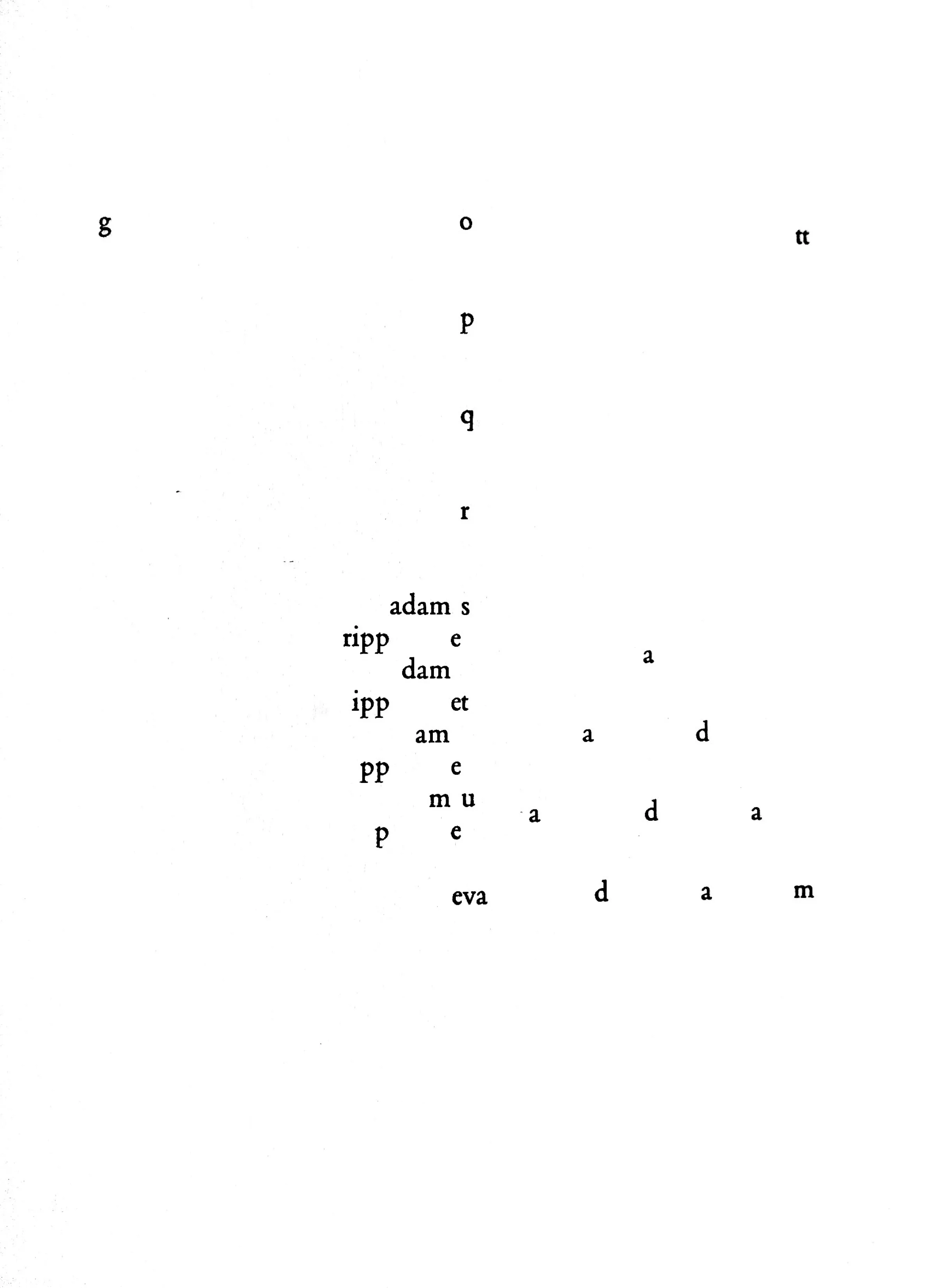
The poem was analysed in a recent article by Brian McAllister, who argues that «Jandl’s poem triggers its intertextual link through the title and through recognizably biblical words within the text […] This intertextuality filters our reading of the poem and provides the visual and semantic elements their [sic] narrative thrust» (McAllister 2014: 237). Here the title plays a key role in directing our reading-viewing of the poem, providing an exemplary case of the authorial use of paratextual devices as self-commentary, to which I was referring earlier on.
While I am persuaded by McAllister’s reading of the placement of individual letters and especially of the final line as ‘enacting’ the creation of Eve, I am more doubtful about his interpretation of the «visual shape» of the poem as evoking «a biblical storyworld inhabited by natural and supernatural beings» (238). Can you see anything in the shape composed by the arrangement of the letters on the page?
M.S.: It’s a fun poem, isn’t it? No, despite trying, I can’t myself see anything iconic here. But I wonder if that isn’t the point – it’s about the primordial act of divine Creation (one thinks of the beginning of John’s Gospel – «in the beginning was the Word», etc.): from the horizontal thrust of «Gott» we move in all manner of directions. The alphabetical sequence of letters is especially interesting, running down the vertical (from the ‘o’ of Gott to the ‘v’ of Eva) – thereby signaling an invention of both space and time. I particularly like the disintegration of words to form new ones (figuring, or indeed literalizing through letters, the deconstruction of Adam and reconstruction of Eva). It’s a peculiarly elemental view of language that actually relates back to Optatian: words are broken down to their bare, atomistic components – and then rebuilt to form new ones. We don’t have the same ‘gridded’ backdrop, but the ‘spoliation’ of language has much in common, I think. Likewise the resulting patterns – the arrangement of letters across diagonals – could take us back to the spatial layouts of those Tabulae Iliacae ‘magic square’ arrangements.
F.P.: I wonder if a closer look at the process of reading as seeing might help us here, especially when it comes to the interaction between the shapes we recognize and the words we single out. According to Willard Bohn, there are three operations involved in the process of «reading a visual poem» (Bohn 2011: 15): the perception-recognition of the composition’s design, the deciphering of the text, and finally the synthesizing of the information acquired through the two previous stages, very often changing the first interpretation. This description of the process seems applicable to picture-poems in which the shape composed by the words is prominent and clearly identifiable, as in some of the calligrams we have seen before; but in the case of Jandl’s poem, where the recognition of a design remains tentative, I would argue that the perception of words in their notational nature precedes the identification of a design.
M.S.: Yes, I think I’d agree. The thing about a poem like this – as with Optatian’s works – is that once the poet opens the hermeneutic gates, it’s left to the reader to draw the semantic limits. Here, as with Optatian, the boundaries between ‘sense’ and ‘nonsense’ are open to question: who’s to decide whether additional patterns – further sites/sights of significance – belong to the poem or to its readers? One might think of Susan Stewart’s work in particular: for both Jandl and Optatian, as for Stewart, puzzling over the ‘nonsensical’ plays a key role interrogating how meanings are constructed – nonsense «not only exaggerates features of common-sense reasoning to make them problematic, it also exaggerates aspects of the language in which that common sense is constructed, pointing to the arbitrary and potentially ‘treacherous’ nature of language as pure form» (Stewart 1978: 201).
In Jandl’s particular example, we could of course dream up all sorts of explanations as we puzzle over the individual letters and their visual arrangement. Looking at the final line, with its letters EVADAM (spread unevenly across the space), we could think of the literalized resulting unity of Eva and Adam – which is ultimately, of course, the whole point of the Genesis story. But what’s to stop us reading along other interpretive lines? Thinking in English (rather than German), one might talk of an ‘evading’, or else of a damning curse (EVA-DAM). One might possibly go still further, thinking of this creation of ‘Eva’ in Buddhist terms (desperately trying to ‘crack’ the riddle, I see ‘dam’ can refer to Atisha’s special Lamrim instructions known as ‘the stages of the path to enlightenment’ – not wholly irrelevant to this whole story, one might think!). Now, I’m not of course staking anything on any of these readings. Rather, what interests me is the challenge a poem like this poses to the conventional rule-book of written, textual communication: to be faced with the poem is perhaps to be faced with a riddling invitation to go off in our own interpretive direction…
F.P.: Albeit, of course, within the overriding frame of the poem’s title (in this case, ‘Die Erschaffung der Eva’). The influence that the title of a picture-poem is likely to exert on our perception as reader-viewers made me think of a second modern case study – this time, a short prose text by Leigh Hunt (1784–1859) on ‘An Evening Landscape’.
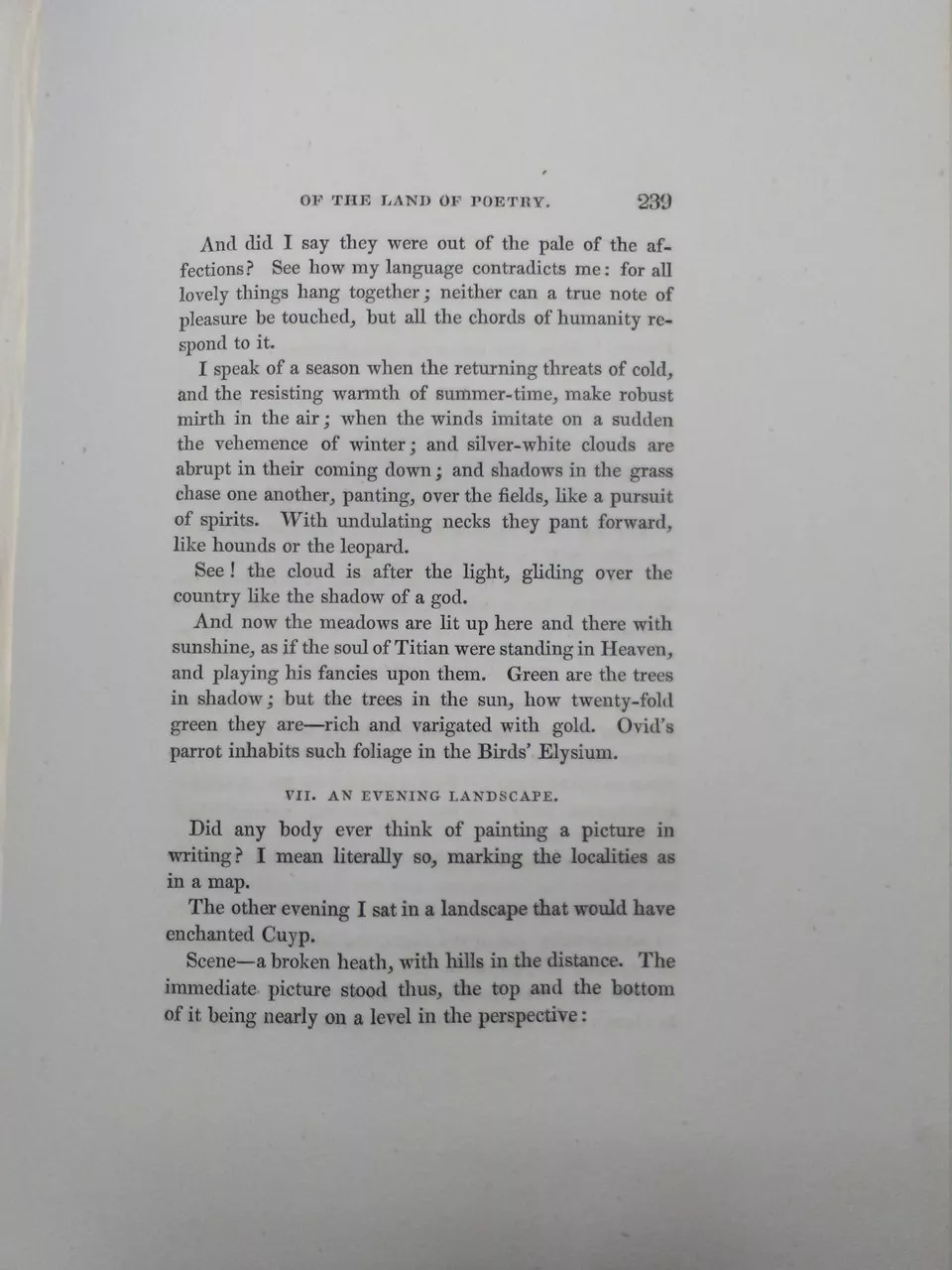
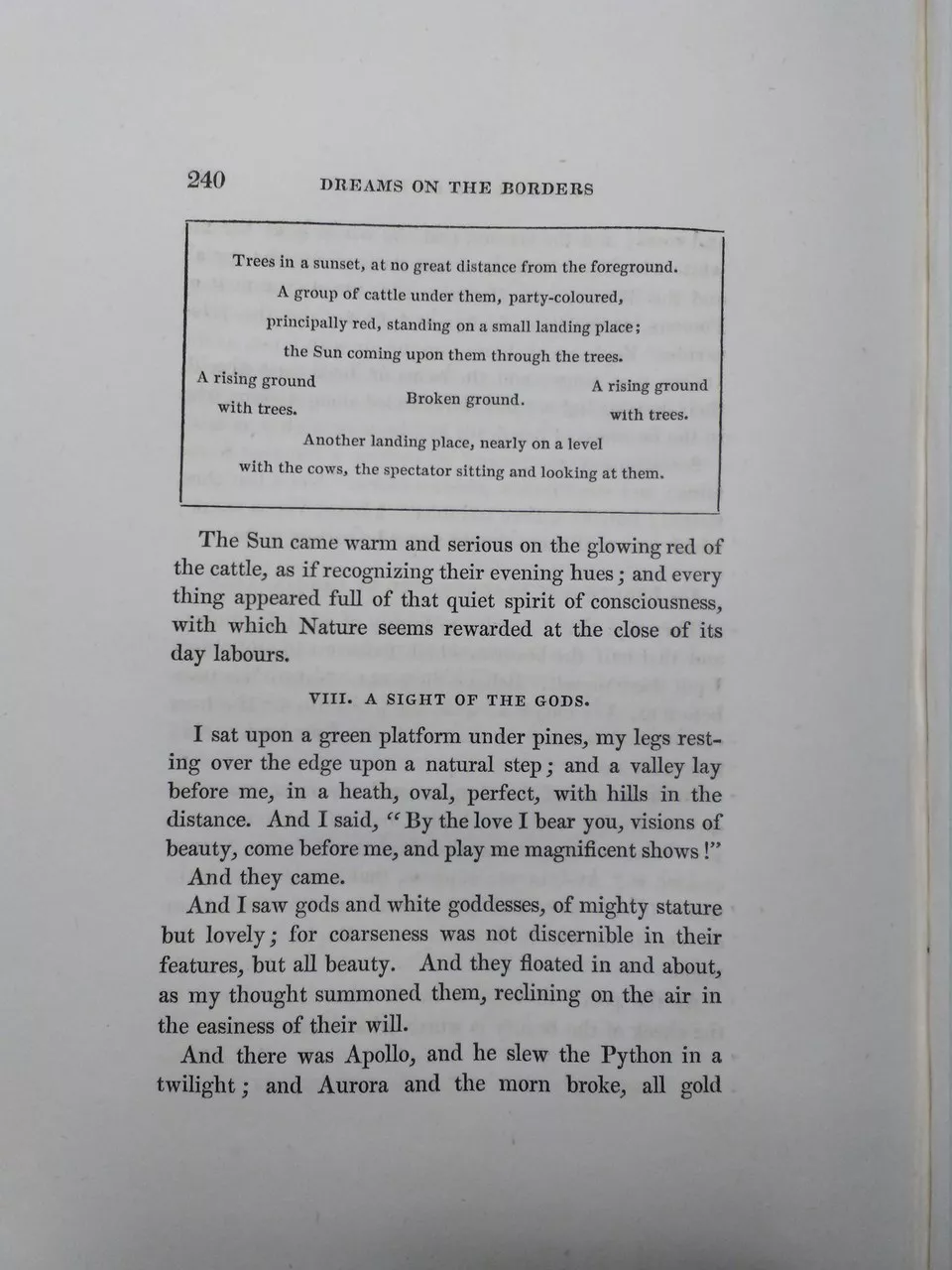
It’s the text which John Hollander chose as a concluding case study for the introduction to the 1995 book we’ve already mentioned (The Gazer’s Spirit: Poems Speaking to Silent Works of Art: Hollander 1995: 88–91).
The passage is part of a series of prose fragments entitled On the Borders of the Land of Poetry, which appeared for the first time in the The Keepsake for 1828 (234-241, at 239-240); it was also collected posthumously as the opening piece in Hunt’s Essays, first published in 1888 (1-7, at 5-6). Hunt’s own preface to the series (‘The Demands of Poetry’) is ambiguous in renouncing poetry while expressing an aspiration towards it:
But I have the wish to be a poet, and thoughts will arise within me as painful not to express as a lover’s. I therefore write memorandums for verse; – thoughts that might perhaps be worthy of putting into that shape, if they could be properly developed […]. (Hunt 1828: 235).
The material relationship between the title, which could also be read as a caption for a painting (‘An Evening Landscape’), and the ‘painting’ enclosed in the linear frame printed on the page is mediated by the words written above and below the frame itself. If read in the order in which they appear on the page, the words encourage a meta-textual reading, which would be less prominent if the prose did not open with these words: «Did anybody ever think of painting a picture in writing? I mean literally so, marking the localities as in a map».
M.S.: It’s a different case study isn’t it – but an interesting one. I think you’re absolutely right about the importance of frame – or rather of different frames (a long-standing interest: cf. Platt and Squire 2017): first, the conceptual framing of the exercise within a critical reflection ‘on the borders of poetry’; and second, the physical framing of Hunt’s poem within those reflections – marked out on the page within a privileged space that brings to mind the physical picture-frame of a painted canvas. Incidentally, I think, the exercise only makes sense within the intellectual framework of what Lessing’s famously prescribed about the ‘boundaries’ (or Grenzen) of ‘painting’ and ‘poetry’, within his landmark 1766 essay on Laokoon (translated as Lessing 1984)…
The framed poem is both removed from the frame of criticism and continuous with it. It’s a point that takes us back to your citation about ambiguity – of «thoughts that might perhaps be worthy of putting into that shape, if they could be properly developed». Of course, this particular example of «painting a picture in writing» is rather different from some of the others we’ve talked about so far. Rather than visualize any mimetic or iconic form, what we find here is a ‘picturesque’ instead of ‘pictorial’ poem.
What do you make of what’s going on?
F.P.: It’s maybe worth noting that, after the pseudo-accidental introduction we both referred to («Did anybody ever think…»), the concise narrative of a very recent past steps in («The other evening…»), along with the mention of a seventeenth-century Dutch painter, Aelbert Cuyp (1620-1691). The subsequent description of the scene is significantly cast within a nominal sentence. What is seen seems to turn instantly, in the very act of perception, into an «immediate picture», with a top and a bottom line that both provide the dominant, horizontal note of the picture painted in writing. To be precise, the act of seeing is not mentioned here, as the subject is sitting «in a landscape», as if he were part of a life-scale painting or tableau-vivant. Within the picture-poem proper, the spectator comes in at the very end, this time sitting but also explicitly looking at the cattle.
If we now enter the space within the frame, again we find nominal sentences (with verbs present only in participle form), forming a list. Prepositions and grammatical links are still in place. But the exclusive presence of nominal sentences seems to respond to the attempt to escape linguistic connections and mimic the juxtaposition of objects. If we move from grammar and syntax to layout, the first four lines in the frame are the least visually prominent, in the sense that they have been subject to a minimal deviation from the conventional graphic arrangement of a poem. By contrast, the central section is the most obviously unorthodox, with the two groups of trees gathering at the sides, on top of two hills («rising ground»), open as stage wings for the lower «broken ground» in the middle, standing for the «broken heath» mentioned outside the frame. The word «ground» appears no fewer than four times (one of which in ‘fore-ground’), whereas «landing place» features twice, again hinting at the flat and horizontal format of the written picture.
Speaking of format, what would you make of Hunt’s insistence on a somewhat narrow «perspective»? The comment «nearly on a level in the perspective», placed before the frame, seems to be confirmed in the first line of the poem-painting («at no great distance») and it is echoed more closely in its penultimate line («Another landing place, nearly on a level»).
M.S.: Within the frame of the poem, Hunt’s talk of the «level in the perspective» seems fundamental, doesn’t it? The individual verses, centred around the «broken ground» in the middle, mirror the imagined spatial layerings of a picture from background at the top (albeit as expressed in language, now «at no great distance from the foreground»), all the way to the foreground at the bottom (which further extends to encompass «the spectator sitting and looking» – and indeed the external viewer who reads in turn of that looking spectator…). The lines of the poem, in other words, are written with a view to the rules of linear perspective. And yet, at the same time, that promise of space in turn ‘breaks’ the linearity of words: either side of the phrase «broken ground», but spatially above and below the central phrase, we find two self-contained semantic units that take semantic advantage of their break from linearity («A rising ground with trees»).
F.P.: Likewise the non-mimetic dispositions of groups of words (never fewer than two at a time) within the frame match the idea of «marking the localities as in a map», a process that ultimately concerns words located in an image (the scale reproduction of a space) rather than the composition of an image proper.
As opposed to the extreme atomization, almost dissolution of the verbal texture in Jendl’s poem, here the fragmentation happens at the level of syntax and grammar, even though punctuation is still present. Verbal sentences reappear only after the frame, in the closing section, which has a strange status as opposed to the clearly meta-textual nature of the prose preceding the frame: on the one hand, it seems to build on the framed ‘picture’, taking up its «Sun»; on the other, it raises the style to recall a more solemn rapture in front of the evening light and concluding on the least visible of things, «Nature’s quiet spirit of consciousness»…
M.S.: Yes, that phrase «quiet spirit of consciousness» must be key to the whole thing – what a wonderful encapsulation of the underlying romanticism! Hunt surely knew well that lots of people had thought of «painting a picture in writing». But despite the promise of literalizing that metaphor, the very framing of the framed ‘picture’ shows that his prose description can nonetheless prove the most ‘pictorial’. Part of the game, I think, lies in the fact that the final paragraph is pregnant with much more ‘visuality’ than the poem itself: «the Sun came warm and serious on the glowing red of the cattle, as if recognizing their evening hues; and everything appeared full of that quiet spirit of consciousness»…
F.P.: Interesting: yes, a pivotal turn of some kind occurs between the lower line of the rectangular frame and what follows. Now, as soon as I say ‘what follows’ I realize how strongly my words are biased by a temporal mindset, whereas I could just as well have said ‘what is placed below the frame’ or so, phrasing the same thought in a more ‘spatial’ way… I guess this brings us full circle, to what Baxandall called description’s «past tense and cerebration»…
We have talked a great deal about long histories, legacies and issues of method. With that in mind, I thought we might therefore conclude by discussing the books and critics that have most influenced our respective studies of visual-verbal relations. I can imagine there are many you could mention, but, if you had to choose just one, what would you say?
M.S.: Lots to think of – in classics, the work of Jaś Elsner would have to loom the largest (e.g. Elsner 1995, 2007); more broadly, a favourite would be the work of W.J.T. Mitchell (especially Mitchell 1986). But – if it’s got to be just one choice – I’m going to give a more offbeat answer: Joseph Koerner’s 2004 book, The Reformation of the Image (Koerner 2004).
The brilliance of Koerner’s volume lies in showing how our whole thinking about words and images is theologically conditioned, and conditioned above all by the thinking of the sixteenth-century Reformation. For me, this work had a huge influence not only in making sense of the historiography of art history as an academic discipline, but also in thinking about the different cultural landscapes of classical antiquity. I hadn’t read the book before completing my doctoral thesis, but it loomed large in the subsequent book that derived from it; in fact, the whole first section of the book is in some ways a reformulation and extension of Koerner’s provocative thesis that ‘the Reformation reshaped what the visual image is’ (Koerner 2004: 246; cf. Squire 2009: 1-193).
What would your answer to the same question be?
F.P.: I guess my answer might surprise you, as my first thought instinctively goes to a book that has nothing to do with either ekphrasis or intermediality: Erich Auerbach’s Mimesis (1946). The book emphasizes the need to engage with a longue durée of literary genres and critical traditions, no matter how much time and work that requires (and no matter how many inevitable simplifications it implies). I treasure the book for many reasons, but most of all because of its unique combination of insightful textual analyses and daring (almost breathtaking) historical perspective. In no other book have I found the same powerful combination of the infinitely small (a paragraph, a canto) and the vast horizons of literary history, the same masterly handling of close reading and wide-ranging reflections on literary genres. I am well aware that the so-called ‘stylistic criticism’ is hardly palatable to British academia, yet it is still an essential practice of literary studies on the continent, and especially in Italy.
Alongside Auerbach, I would also mention Ernst Robert Curtius, whose European Literature and the Latin Middle Ages (1948) sparked my passion for the study of topoi in both texts and images. In a REF-dominated world of British academia, I feel sure, the masterpieces of Auerbach and Curtius would never have seen the light of day. By contrast, some of today’s most renowned academic journals are packed with peer-reviewed articles so much narrower in scope. I have the deepest respect for any honest, well-conducted and rigorous research. Yet, as a reader, my sense is that the critical potential inherent in the clash of the minute detail and the distant view, in the risk of wide-ranging synthesis, cannot be rivaled by that of a single case study, no matter how brilliant. Like the artists of those Tabulae Iliacae, Auerbach and Curtius are both masters of combining the microscale with the macroscale!
But I’m going to give a third answer too. With regard to the specific topic of our conversation, the work of Michael Baxandall has to feature. The first of Baxandall’s books that I read was Painting and Experience in Fifteenth Century Italy (Baxandall 1972), although I think I read it too early fully to realize its implications. Another which has stayed with me for even longer is Giotto and the Orators (Baxandall 1971). More recently I find myself referring back more and more often to Patterns of Intention (Baxandall 1985), which is an exemplary book on art historical method.
Baxandall’s work, especially in Patterns of Intention, is an outstanding example of how an interest in social contexts and their influence can go hand in hand with the most subtle awareness of rhetorical patterns and conventions. Every paragraph of Baxandall’s writings shines with his sharp intelligence – an unmistakable mixture of pragmatism with fearless theoretical drive. I know that I am stating the obvious here, but the obvious is less so when one considers the possibility of building on his model. It is certainly possible to adopt Baxandall’s method – or parts of it, for example to work along the lines of Giotto and the Orators or Painting and Experience; but what remains beyond reach is his unique style of thought, the distinctive personality shining through his thought and writing. One cannot really imitate Baxandall, and yet this is the very reason why it is so useful to read his work.
To return finally to ekphrasis, I love Baxandall’s definition of description (or more precisely of «a partially interpretative description»), as «an untidy and lively affair», which appears in the introductory essay ‘Language and explanation’, right at the beginning of Patterns of Intention (Baxandall 1985: 11). Again and again, I find inspiration in Baxandall’s moderate skepticism about inferential criticism, in so far as it implies a positive take on the weaknesses inherent in our methods, and ultimately the choice of being optimistic without being naïve.
M.S.: Baxandall might likewise give us a note on which to end, mightn’t he? After all, Baxandall is one of those key (and all too few!) figures who succeeded in building bridges between the study of ancient and early modern visual culture: I remember, for example, how Baxandall begins Patterns of Intention by analyzing a description by Libanius of a painting in the Council House in Antioch (Baxandall 1985: 1–5).
By contrast, the field of art history – generally speaking – has not been good at crossing the ancient/modern divide. Two hundred years or so ago, when ‘art history’ first grew out of aesthetics and philosophy, before being nurtured as an academic discipline of its own, almost every discussion of aesthetics, replication and vision drew upon ancient writings and examples (not least in Germany – consider the likes of Winckelmann, Lessing, Herder, Goethe and Hegel). The same can be said for the turn of the nineteenth and twentieth centuries, when art historians were still trained as much in the ancient as in the modern (especially, once again, in the Germanic tradition of Riegl, Wölfflin, Cassirer, Saxl, Warburg, Panofsky, etc.). After fleeing the Nazis, and re-establishing itself in London in 1933, the ‘Warburg Institute’ here in London could still define its academic remit in terms of a ‘classical tradition’ – and of the Nachleben (‘afterlife’) of Graeco-Roman images in particular.
Today we have ended up in the reverse situation. Most departments of art history and visual culture are entirely divorced from faculties of classics and classical archaeology. Much to my chagrin, the Courtauld Institute of art – where you’re currently based – has effectively given up teaching classical materials: it abandoned its full-time post in Greek and Roman art in 2011, and to date there’s no sign of it being reinstated … A whole series of additional institutional barriers police the boundaries: university curricula, departments, and not least appointment committees. This current situation stems in no small part from the aesthetic backlashes of the twentieth century, with its various calls to look forwards, not back. It’s a delicious irony: had Graeco-Roman art not been so historically influential, it might well have a greater academic presence within departments of art history today…
Some classicists have been only too glad to see the ‘ancient’ and ‘modern’ go their separate ways. Uninterested in bigger art historical questions, indeed rather embarrassed by them, classical art historians have sometimes preferred to pore over their relics in splendid antiquarian isolation (cf. Squire 2012). Why should we want to force Graeco-Roman art «into anthropological moulds and structures» or «subject it to the service of ideologies bred by modern concerns with race, gender and psychology?», one prominent voice has asked (Boardman 1993: 2). Other classicist scholars and archaeologists have sought to abandon visual cultural questions altogether: «all art is material culture...», as one trenchant ‘material culturalist’ insists: «classical art history therefore is archaeology or it is nothing» (Whitley 2001: xxiii).
That gloomy backdrop makes conversation here all the more important, I think. Within classics, at least, it’s never been more important to be looking outwards. Here’s hoping that there’ll be more occasions in the future!
Bibliography:
Amedick 1999
R. Amedick, ‘Der Schild des Achilleus in der hellenistisch-römischen ikonographischen Tradition’, Jahrbuch des Deutschen Archäologischen Instituts,114 (1999), pp. 157-206.
Auerbach 1946
E. Auerbach, Mimesis. Dargestellte Wirklichkeit in der abendländischen Literatur. Bern, Francke, 1946.
Barkan 2013
L. Barkan, Mute Poetry, Speaking Pictures, Princeton, Princeton University Press, 2013.
Baxandall 1971
M. Baxandall, Giotto and the Orators. Humanist Observers of Painting in Italy and the Discovery of Pictorial Composition, 1350-1450, Oxford, Oxford University Press, 1971.
Baxandall 1972
– Painting and Experience in Fifteenth Century Italy. A Primer in the Social History of Pictorial Style, Oxford, Oxford University Press, 1972.
Baxandall 1985
– Patterns of Intention. On the Historical Explanation of Pictures, New Haven and London, Yale University Press, 1985.
Benndorf 1862
O. Benndorf, De Anthologiae Graecae epigrammatis quae ad artes spectant, Leipzig, G. B. Teubner, 1862.
Benassi 2008
A. Benassi, ‘Tanto di senso copioso, e abbondante. Note sulla Virginia di Ercole Tasso’, in L. Bolzoni and S. Volterrani (eds.), Con parola brieve e con figura. Emblemi e imprese fra antico e moderno, Pisa, Edizioni della Normale, 2008, pp. 421-450.
Boardman 1993
J. Boardman (ed.), The Oxford History of Classical Art. Oxford, Oxford University Press, 1993.
Bolzoni 1995
L. Bolzoni, La stanza della memoria. Modelli letterari e iconografici nell’età della stampa, Torino, Einaudi, 1995.
Campbell 2005
S.J. Campbell, ‘Eros in the Flesh: Petrarchism, the Embodied Eros and Male Beauty in Italian Art, 1500-1540’, Journal of Medieval and Early Modern Studies, 35 (2005), pp. 629-662.
Crescenzo 1999
R. Crescenzo, Peintures d’instruction. La postérité littéraire des Images de Philostrate en France de Blaise de Vigenère à l’époque classique, Genève, Droz, 1999.
Cropper 1976
E. Cropper, ‘On Beautiful Women: Parmigianino, “Petrarchismo” and the Vernacular Style’, Art Bulletin, 58 (1976), pp. 374-394.
Cropper 1986
– ‘The Beauty of Woman: Problems in the Rhetoric of Renaissance Portraiture’, in M.W. Ferguson, M. Quilligan, N. Vickers (eds.), Rewriting the Renaissance: the Discourses of Sexual Difference in Early Modern Europe, Chicago, University of Chicago Press, 1986, pp. 175-190.
Curtius 1948
E. R. Curtius, Europäische Literatur und lateinisches Mittelalter, Bern, Francke, 1948.
D’Elia 2006
U.R. D’Elia, ‘Niccolò Liburnio on the Boundaries of Portraiture in the Early Cinquecento’, The Sixteenth Century Journal, 37 (2006), pp. 323-350.
Dempsey 1992
C. Dempsey, The Portrayal of Love. Botticelli’s Primavera and Humanistic Culture at the Time of Lorenzo the Magnificent, Princeton, Princeton University Press, 1992.
Dempsey 2012
– The Early Renaissance and Vernacular Culture, Cambridge, MA, Harvard University Press, 2012.
Dencker 2011
K.P. Dencker, Optische Poesie. Von den prähistorischen Schriftzeichen bis zu den digitalen Experimenten der Gegenwart, Berlin, de Gruyter, 2011.
Drucker 1998
J. Drucker, Figuring the Word. Essays on Books, Writing an Visual Poetics, New York, Granary Books, 1998.
Eco 1994
U. Eco, Reflections on the Name of the Rose, trans. W. Weaver, 2nd ed. London, Minerva, 1994.
Elsner 1995
J. Elsner, Art and the Roman Viewer. The Transformation of Art from the Pagan World to Christianity. Cambridge, Cambridge University Press, 1995.
Elsner 2007
– Roman Eyes: Visuality and Subjectivity in Art and Text. Princeton, Princeton University Press, 2007.
Ernst 1991
U. Ernst, Carmen figuratum. Geschichte des Figurengedichts von den antiken Ursprüngen bis zum Ausgang des Mittelalters, Cologne, Böhlau, 1991.
Ernst 2012
– Visuelle Poesie. Historische Dokumentation theoretischer Zeugnisse. Band I: Von der Antike bis zum Barock, Berlin, de Gruyter, 2012.
Ernst forthcoming
– Visuelle Poesie. Historische Dokumentation theoretischer Zeugnisse. Band II: Vom Spätbarock bis zur Gegenwart, Berlin, de Gruyter, forthcoming.
Goethe 1986
J.W. Goethe, Essays on Art and Literature. Goethe’s Collected Works, Volume 3, ed. John Gearey. trans. E. von Nardroff and E. H. von Nardroff, New York, Princeton University Press, 1986.
Gow and Page 1965
A.S.F. Gow, and D.L. Page (eds.), The Greek Anthology. Hellenistic Epigrams, 2 vols, Cambridge, Cambridge University Press, 1965.
Higgins 1987
D. Higgins, Pattern Poetry: Guide to an Unknown Literature, Albany, NY, State University of New York Press, 1987.
Hollander 1995
J. Hollander, The Gazer’s Spirit: Poems Speaking to Silent Works of Art, Chicago, University of Chicago Press, 1995.
Koerner 2004
J. Koerner, The Reformation of the Image, Chicago and London, The University of Chicago Press, 2004.
Kohl, Koos and Randolph 2014
J. Kohl, M. Koos, and A. Randolph (eds.), Renaissance Love. Eros, Passion, and Friendship in Italian Art around 1500, Berlin, Deutscher Kunstverlag, 2014.
Krämer 2005
S. Krämer, ‘“Operationsraum Schrift”: Über einen Perspektivenwechsel in der Betrachtung der Schrift’, in G. Grube. W. Kogge and S. Krämer (eds.), Schrift. Kulturtechnik zwischen Auge, Hand und Maschine, Munich, Fink, 2005, pp. 23-61.
Krämer, Cancik-Kirschbaum and Totzke 2012
S. Krämer, E. Cancik-Kirschbaum, and R. Totzke, (eds.) Schriftbildlichkeit. Wahrnehmbarkeit, Materialität und Operativität von Notationen, Berlin, Akademie Verlag, 2012.
Kwapisz 2013
J. Kwapisz, The Greek Figure Poems, Leuven, Peeters, 2013.
Lagner 2001
M. Lagner, Antike Graffitizeichnungen. Motiv, Gestaltung und Bedeutung, Wiesbaden, Ludwig Reichert, 2001.
Leach 2004
E. W. Leach, The Social Life of Painting in Ancient Rome and on the Bay of Naples, Cambridge, Cambridge University Press, 2004.
Lessing 1984
G. E. Lessing, Laocoön. An Essay on the Limits of Painting and Poetry. Translated by E. A. McCormick. Baltimore, MD and London, Johns Hopkins University Press, 1984.
Lissarrague 1992
F. Lissarrague, ‘Graphein: écrire et dessiner’, in C. Bron and E. Kassapoglou (eds.), L’image en jeu. De l’antiquité à Paul Klee, Yens-sur-Morge, Cabédita, 1992, pp. 189–203.
Maffei 2015
S. Maffei, ‘I limiti dell’ekphrasis: quando i testi originano immagini’, Studi di Memofonte, 15 (2015), pp. 120-146.
Maggi 1995
A. Maggi, ‘Depicting one’s self: imprese and sonnets in La Virginia overo la dea de’ nostri tempi by Ercole Tasso’, Quaderni d’Italianistica, 16 (1995), pp. 51-60.
Maggi 1998
– Identità e impresa rinascimentale. Ravenna, Longo, 1998.
Maggi 2006
– ‘Una figura poco conosciuta del tardo Rinascimento: Ercole Tasso e i suoi due canzonieri’, Esperienze letterarie, 31 (2006), pp. 3-38.
Magnien 1996
A. Magnien, ‘Callistrate et le discours sur la sculpture à l’âge moderne’, in Antiquités imaginaires. La reference antique dans l’art occidental de l’Antiquité à nos jours, Textes édités par Ph. Hoff et P. Rinuy, Paris, Éditions Rue d’Ulm, 1996, pp. 21-41.
Männlein-Robert 2007
I. Männlein-Robert, Stimme, Schrift und Bild. Zum Verhältnis der Künste in der hellenistischen Dichtung, Heidelberg, Winter, 2007.
Marek 1985
M. Marek, Ekphrasis und Herrscherallegorie. Antike Bildbeschreibungen im Werk Tizians und Leonardos, Worms, Wernersche Verlagsgesellschaft, 1985.
McAllister 2014
B.J. McAllister, ‘Narrative in Concrete / Concrete in Narrative: Visual Poetry and Narrative Theory’, Narrative, 22 (2014), pp. 234-251.
Mitchell 1986
W.J.T. Mitchell, Iconology. Image, Text, Ideology, Chicago, The University of Chicago, 1986.
Mitchell 1994
– Picture Theory. Essays on Verbal and Visual Representation, Chicago, The University of Chicago, 1994.
Muth, Neer and Webb 2012
S. Muth, R. Neer and R. Webb, ‘Débat: texte et image dans l’Antiquité: lire, voir et percevoir’, Perspective (2012), pp. 11-28.
Nerlich 1990
M. Nerlich, ‘Qu’est-ce qu’un iconotexte? Réflexions sur le rapport texte-image photographique dans “La femme se découvre”’, in A. Montandon (ed.), Iconotextes, Paris, Ophrys, 1990, pp. 255-303.
Osborne and Pappas 2007
R. Osborne, and A. Pappas, ‘Writing on Archaic Greek Pottery’, in Z. Newby and R. Leader-Newby (eds.), Art and Inscriptions in the Ancient World, Cambridge, Cambridge University Press, 2007, pp. 131-155.
Pich 2008a
F. Pich, ‘I testi’, in L. Bolzoni, Poesia e ritratto nel Rinascimento, testi a cura di F. Pich, Roma-Bari, Laterza, 2008.
Pich 2008b
– ‘Specchi, ritratti, sonetti: ellissi dell’immagine e memoria degli oggetti nella lirica del Cinquecento’, in F. Cattani and D. Meneghelli (eds.), La rappresentazione allo specchio. Testo letterario e testo pittorico, Roma, Meltemi, 2008, pp. 87-103.
Pich 2010
– I poeti davanti al ritratto. Da Petrarca a Marino, Lucca, Pacini Fazzi, 2010.
Pich 2016
– ‘Leggere e rileggere discorsi amorosi: processi della lettura tra lirica e epistolografia rinascimentale’, in G. Rizzarelli and C. Savettieri (eds.), C’è un lettore in questo testo? Rappresentazioni della lettura nella letteratura italiana, Bologna, Il Mulino, 2016, pp. 69-92.
Platt and Squire 2017
V.J. Platt, and M.J. Squire (eds.), The Frame in Classical Art: A Cultural History. Cambridge, Cambridge University Press, forthcoming 2017.
Polara 1973
G. Polara, Publilii Optatiani Porfyrii Carmina (2 vols.), Turin, Paravia, 1973.
Polara 2004
– Optaziano Porfirio. Carmi, Turin, UTET, 2004.
Richardson 1999
B. Richardson, Printing, Writers and Readers in Renaissance Italy, Cambridge, Cambridge University Press, 1999.
Richardson 2009
– Manuscript Culture in Renaissance Italy. Cambridge, Cambridge University Press, 2009.
Squire 2009
M.J. Squire, Image and Text in Graeco-Roman Antiquity, Cambridge, Cambridge University Press, 2009.
Squire 2010a
– ‘Making Myron’s Cow Moo? Ecphrastic Epigram and the Poetics of Simulation’, American Journal of Philology, 131 (2010), pp. 589-634.
Squire 2010b
– ‘Reading a View: Poem and Picture in the Greek Anthology’, Ramus, 39 (2010), pp. 73-103.
Squire 2010c
– [Review of Webb 2009], Aestimatio, 5 (2010), pp. 233-244.
Squire 2011
– The Iliad in a Nutshell. Visualizing Epic on the Tabulae Iliacae, Oxford, Oxford University Press, 2011.
Squire 2012
– ‘A place for Art? Classical Archaeology and the Contexts of Art History’, in S. Alcock and R. Osborne (eds.), Companion to Classical Archaeology, second edition. Malden, MA, Wiley-Blackwell, 2012, pp. 468-500.
Squire 2013a
– ‘Ekphrasis at the Forge and the Forging of Ekphrasis: The Shield of Achilles in Graeco-Roman Word and Image’, Word & Image, 29 (2013), pp. 157-191.
Squire 2013b
– ‘Apparitions Apparent: Ekphrasis and the Parameters of Vision in the Elder Philostratus’s Imagines’, Helios, 39 (2013), pp. 97-140.
Squire 2013c
– ‘Invertire l’ekphrasis: l’epigramma ellenistico e la traslazione di parola e immagine’, Estetica: Studi e ricerche (2013), pp. 82-107.
Squire 2014
– ‘The Ordo of Rhetoric and the Rhetoric of Ordo’, in M. Meyer and J. Elsner (eds.), Art and Rhetoric in Roman Culture, Cambridge, Cambridge University Press, 2014, pp. 353-417.
Squire 2015a
– ‘Patterns of Significance: Publilius Optatianus Porfyrius and the Figurations of Meaning’, in R. Green and M. Edwards (eds.), Images and Texts. Papers in Honour of Professor E. W. Handley, CBE, FBA, London, Bulletin of the Institute of Classical Studies Suppl. 129), 2015, pp. 87-120.
Squire 2015b
– ‘Ecphrasis: Visual and Verbal Interactions in Ancient Greek and Latin Literature’, Oxford Handbooks Online, 2015 [DOI: 10.1093/oxfordhb/9780199935390.013.58].
Squire 2016a
– ‘POP Art: The Optical Poetics of Publilius Optatianus Porfyrius’, in J. Elsner and J. Hernández Lobato (eds.), The Poetics of Late Latin Literature. Oxford, Oxford University Press, 2016, pp. 25-99.
Squire 2016b
– ‘“How to Read a Roman Portrait”? Optatian Porfyry, Constantine and the Vultus Augusti’, Papers of the British School at Rome 84 (2016), pp. 179-240.
Squire and Elsner 2016
M. Squire, and J. Elsner, ‘Homer and the ekphrasists: Text and picture in the Elder Philostratus’ Scamander (Imagines I.1)’, in J. Bintliff and K. Rutter (eds.), The Archaeology of Greece and Rome: Studies in Honour of Anthony Snodgrass, Edinburgh, Edinburgh University Press, 2016, pp. 57-99.
Squire and Wienand 2017
M. Squire, and J. Wienand (eds.), Morphogrammata/The Lettered Art of Optatian. Figuring Cultural Transformations in the Age of Constantine, Paderborn, W. Fink, 2017.
Stewart 1978
S. Stewart, Nonsense. Aspects of Intertextuality in Folklore and Literature, Baltimore, Johns Hopkins University Press, 1978.
Stewart 1993
– On Longing. Narratives of the Miniature, the Gigantic, the Souvenir, the Collection, Second edition, Baltimore, Johns Hopkins University Press, 1993.
Tasso 1593a
E. Tasso, La Virginia overo della dea de’ nostri tempi. Trattato ove si hanno Rime, Imprese e dimostrazioni Cabalistiche, Bergamo, Comin Ventura, 1593.
Tasso 1593b
E. Tasso, Poesie del Sig. Hercole Tasso Filosofo, composte da lui, in sua giovanile età, e già spartatamente stampate in Bologna, in Vinegia et in Bergamo. Con brievi dichiarationi, annesse con gl’Indici, sopra le più di loro del Sig. Christoforo Corbelli, Bergamo, Comin Ventura, 1593.
Tebaldeo 1989-1992
A. Tebaldeo, Rime, a cura di T. Basile e J.-J. Marchand, Modena, Panini, 1989-1992.
Tueller 2008
M. A. Tueller, Look Who’s Talking. Innovations in Voice and Identity in Hellenistic Poetry, Leuven, Peeters, 2008.
Wagner 1995
P. Wagner, Reading Iconotexts. From Swift to the French Revolution, London, Reaktion, 1995.
Wagner 1996
– ‘Introduction’, in P. Wagner (ed.), Icons – Texts – Iconotexts. Essays on Ekphrasis and Intermediality, Berlin, de Gruyter, 1996, pp. 1-40.
Webb 1999
R. Webb, ‘Ekphrasis Ancient and Modern: The Invention of a Genre’, Word & Image, 15 (1999), pp. 7-18.
Webb 2009
– Ekphrasis, Imagination and Persuasion in Ancient Rhetorical Theory and Practice, Farnham, Ashgate, 2009.
Whitley 2001
J. Whitley, The Archaeology of Ancient Greece, Cambridge, Cambridge University Press, 2001.
Wojaczek 1988
G. Wojaczek, ‘Schlüssel und Schlange: Zwei figurale Texte aus Antike und Mittelalter’, Würzburger Jahrbücher für die Altertumswissenschaft, 14 (1988), pp. 241-252.
Zanker 2003
G. Zanker, ‘New Light on the Literary Category of “Ekphrastic Epigram” in Antiquity: The New Posidippus (col. X 7 – XI 19 P. Mil. Vogl. VIII 309)’, ZPE, 143 (2003), pp. 59-62.
Zanker 2004
–– Modes of Viewing in Hellenistic Poetry and Art, Madison, WI, The University of Wisconsin Press, 2004.